Creating inclusive future ourselves!
April 2025: The Stadtfabrikanten set off on an extensive (workshop) exploration trip to France. The main goal: to identify open workshops that have experience in the field of inclusion and creating accessibility.
We also want to enter into exchange, collect ideas, solutions and experiences and then free our own place (Stadtwirtschaft) from barriers with concrete approaches and create general awareness that will enable better coexistence in the future. Our Stadtwirtschaft currently still has many spatial barriers.
Our activities are to be continued in the summer in workshops here in Chemnitz, together with French guests.
We are strengthening the existing structures between associations and networks, building international bridges through commonalities and promoting the European idea. And we pass on our mutual knowledge about open workshops.
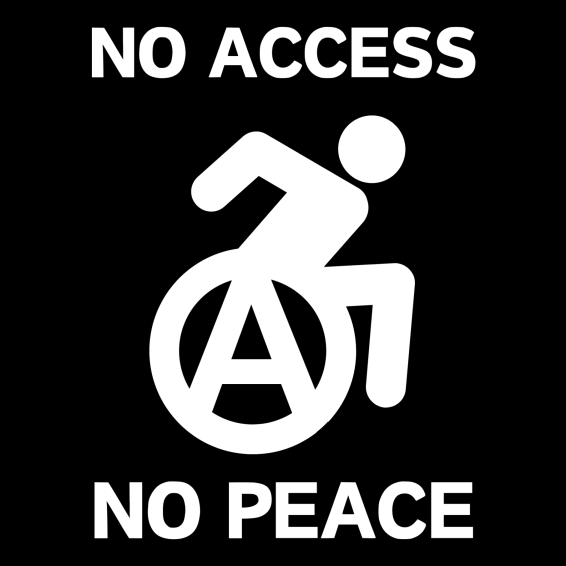
With this package of tasks, three people from our association and our mutual Vulca friend Axel from Erlangen set out to visit dozens of makerspaces and FabLabs in France to get to the bottom of this.
So we formed two teams to roam the country by train and car. Today we are writing our report on the “North Tour” that Babette, Mario and occasionally Axel from ZAM Erlangen embarked on. From 02.-12.04. we were on the road every day. Maik also started the longer “South Tour” at the beginning of April and in between picked up Axel as a jumper from our North Tour.
Presentation
A short, general presentation of our thoughts, which we have taken with us for support on the road, can be found in our HedgeDoc: https://pad.stadtfabrikanten.org/p/2025-dfbf
Travel route
Our itinerary for the “North Tour” looks like this on the map:
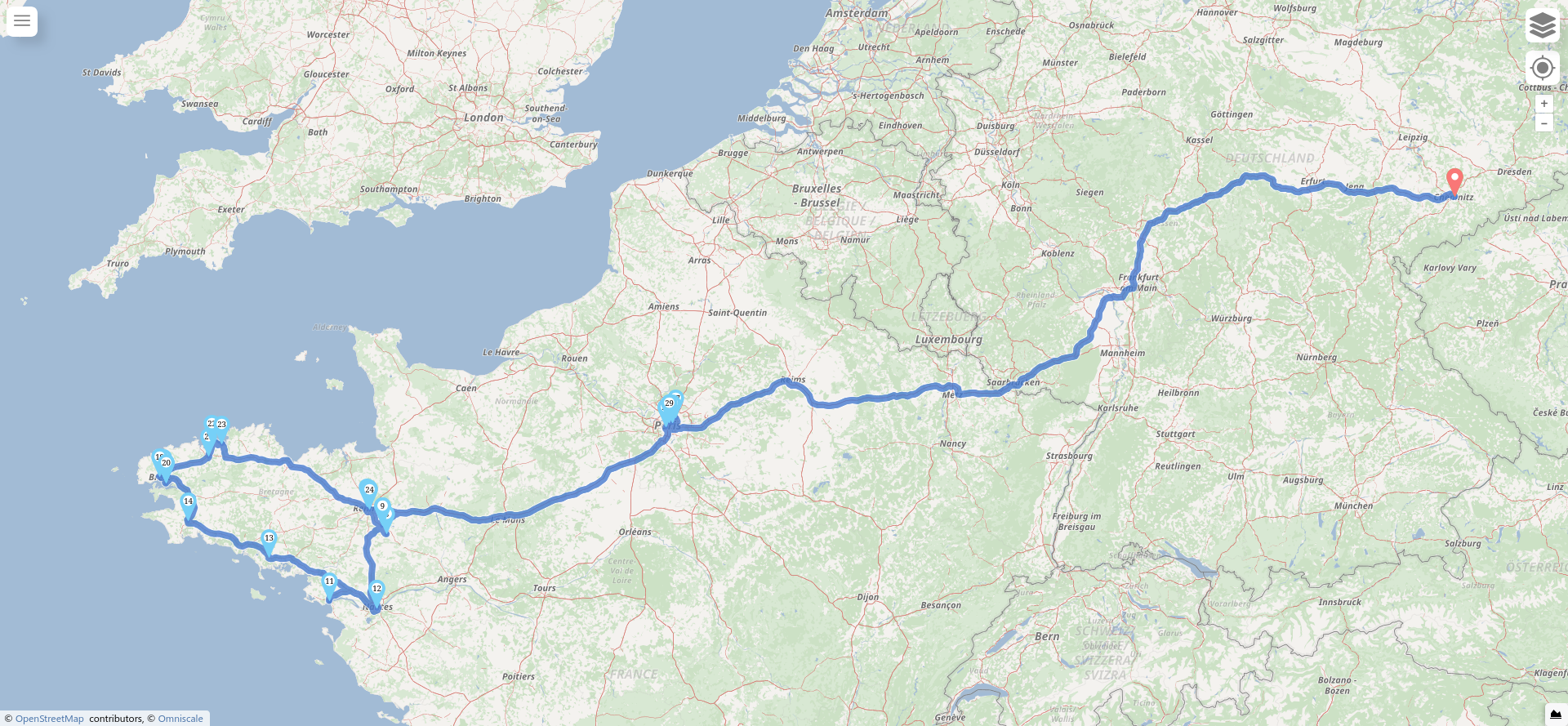
Wednesday 02.04.2025
Start of journey - journey from Chemnitz to Rennes
We got up at 3 a.m. and made our way to our most hateful favorite train from Chemnitz to Leipzig and from there by ICE to Paris. After a few mental battles with exhausting ticket machines, RATP apps and overcrowded metro stations with a moderate battle arena feeling, we reached our first destination in France at around 7 p.m. and with a rebooked journey including a 3-hour delay: the city of Rennes. Rennes is a relatively young, dynamic, chemnitz-sized university city with around 230,000 inhabitants and a fabulous old town.
Arrrrrr'ived!
When we arrived there, a friendly guy with a yellow cap waved to us a little later: Hugues Aubin - the first of our contact pool who was enthusiastic about joining a group of visitors from Chemnitz and gave us a warm welcome. Hugues: a committed all-rounder! With eloquence and humor, he takes us into a part of his world: we drive in his son's old car to Janzé - a small but beautiful village in a commune near Rennes, where Hugues lives and where he is active, among other things. We spend the evening in a lively exchange about construction projects, thoughts and activities from the past and present and where Hugues' journey is currently taking him. He turned his life upside down not so long ago and is already planning a workshop trip to Senégal: carrying out and guiding makerspace projects in a low-threshold environment, where there is no electricity or running water and the everyday routines we are used to are disappearing into thin air. Hugues is also active in a French-African network.
We spend the night in his old town house, which is steeped in history, after spending the evening in the garden and saying hello to his lovely chickens Pascal and Mirabelle. Pascal is a strong chicken with a bad leg. She can no longer walk properly, never could. Hugues has nursed her back to health and done all he can to help her get around - despite all the critics and dissenting voices who said it would be better to give up on her straight away. He even made prostheses and a special egg-laying device for Pascal to support her.
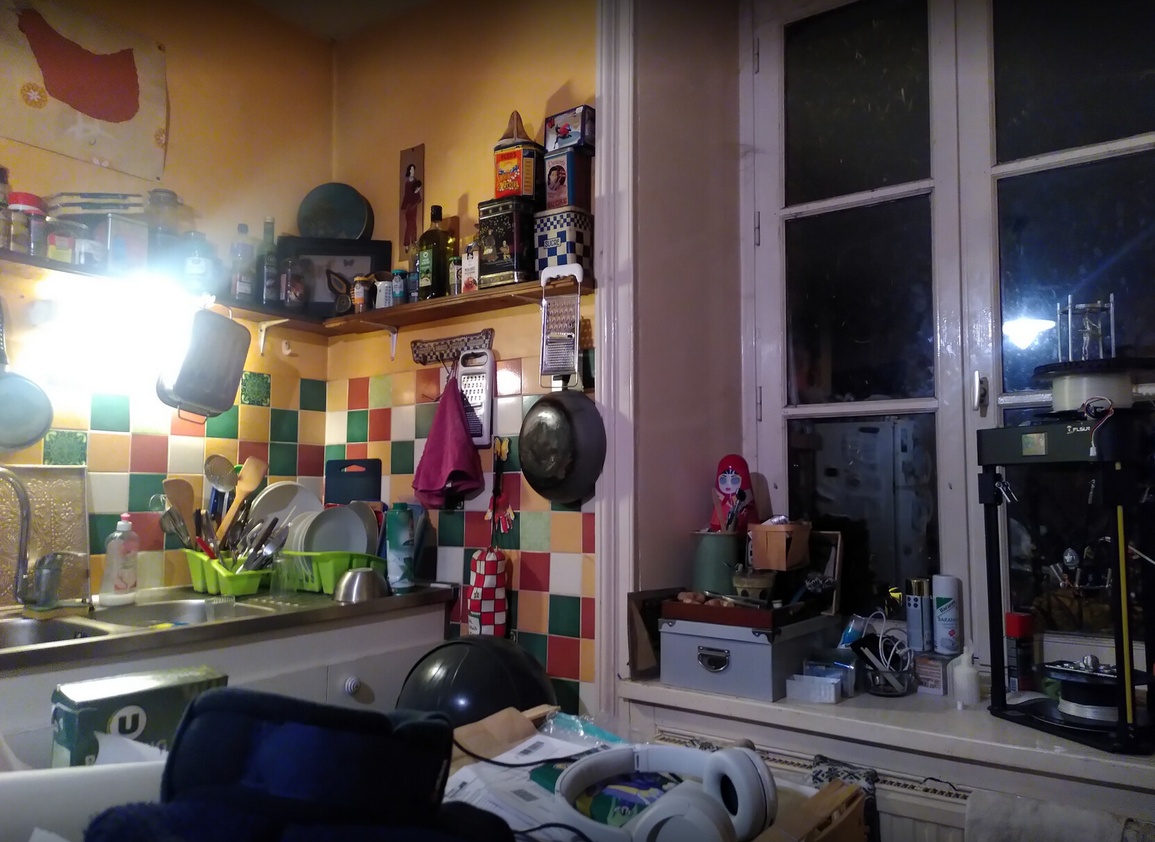
Thursday 03.04.2025
Get up!
Halfway recovered from the exhausting first day of travel, we sit down at the breakfast table with Hugues and a little later we set off - back to Rennes. The first thing we did there was to pick up a pre-reserved rental car from SIXT in Saint-Grégoire. After all, our round trip wouldn't be possible without further ado if we only took public transport, as there wasn't enough time or our planned destinations were too far apart. We get a small, practical Peugeot 208 - enough for 3 people and our luggage.
1. Lab visit: My Human Kit - the Humanlab at ASKORIA, Rennes
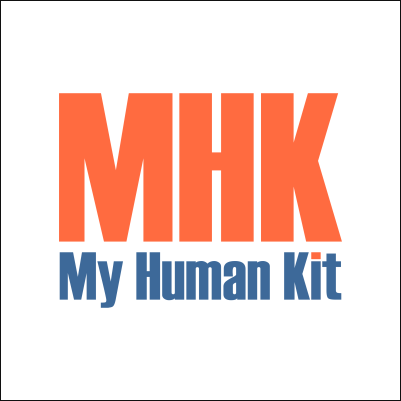
After a quick groove at the wheel, we head straight to My Human Kit with Hugues. This is a workshop that was founded several years ago and is a pioneer of the idea of a "Humanlab".
My Human Kit invites people with disabilities to become the center of their own project, i.e. to transform their disability into motivation. They are asked to participate in solving their problem and to put together a team that uses the combined power of solidarity (All Together), DIY (Do It Yourself) and digital manufacturing (FabLab).
Its aim is to demonstrate and disseminate Humanlabs in which people learn to "repair themselves". In principle, any lab that represents these values (agenda) can call itself a Humanlab. We have learned that there are other Humanlabs in Saint-Pierre, Quimper (Flux) and Nantes (APAJH 44), among others. An informative map can be found on the MHK-Wiki under “Le réseau des Humanlabs”.
We meet a lot of people here at MHK. Among others, we talk to Nicolas Huchet. He is known for his many years of work with various sophisticated hand prostheses and shows us various examples to touch and marvel at. Nicolas is himself a sufferer, but also his own problem solver. He also tells us quite clearly: a place is inclusive and welcoming for people with disabilities if the place lives it, understands it and does not propagate it with hollow phrases. What's important are the people and activities that encourage people to feel that they have arrived here and empower them to be autonomous. People with disabilities do not need an “extra place” where they are secluded. They need inspiration and an open atmosphere.
Yohann Véron is also on site. He is a good friend of Hugues and has also been working for MHK for many years. He is the Lab Manager and shows us various other projects that have already been realized and also that these are very well open source documented. These include many custom-made products such as modified wheelchairs (e.g. drinking cup holders, supports), canes for the blind with LIDAR sensors for extended environment analysis and vibration alarms or practical aids for people who can no longer fully move their arm, for example, and are dependent on devices to dispense eye drops in a well-dosed manner. A first major insight: there are many things that people probably don't even think that they might need - and that there are people who are willing to take on the challenge. My Human Kit has broken this down into various categories - including visual impairment, limited mobility of the upper limbs or general motor skills, deafness and cognitive disorders and others. The wiki is also updated and supplemented annually by students. Unfortunately, it is not yet available in other languages such as German or English.
A special project that we come into contact with here is the "BrailleRAP" device, which is an interesting topic for blind people and one that is still relatively unknown in Germany. But more on that later!
During the conversation, we also learn in passing that My Human Kit is not only a Humanlab, but also part of the "LabFab" network. But more on that later.
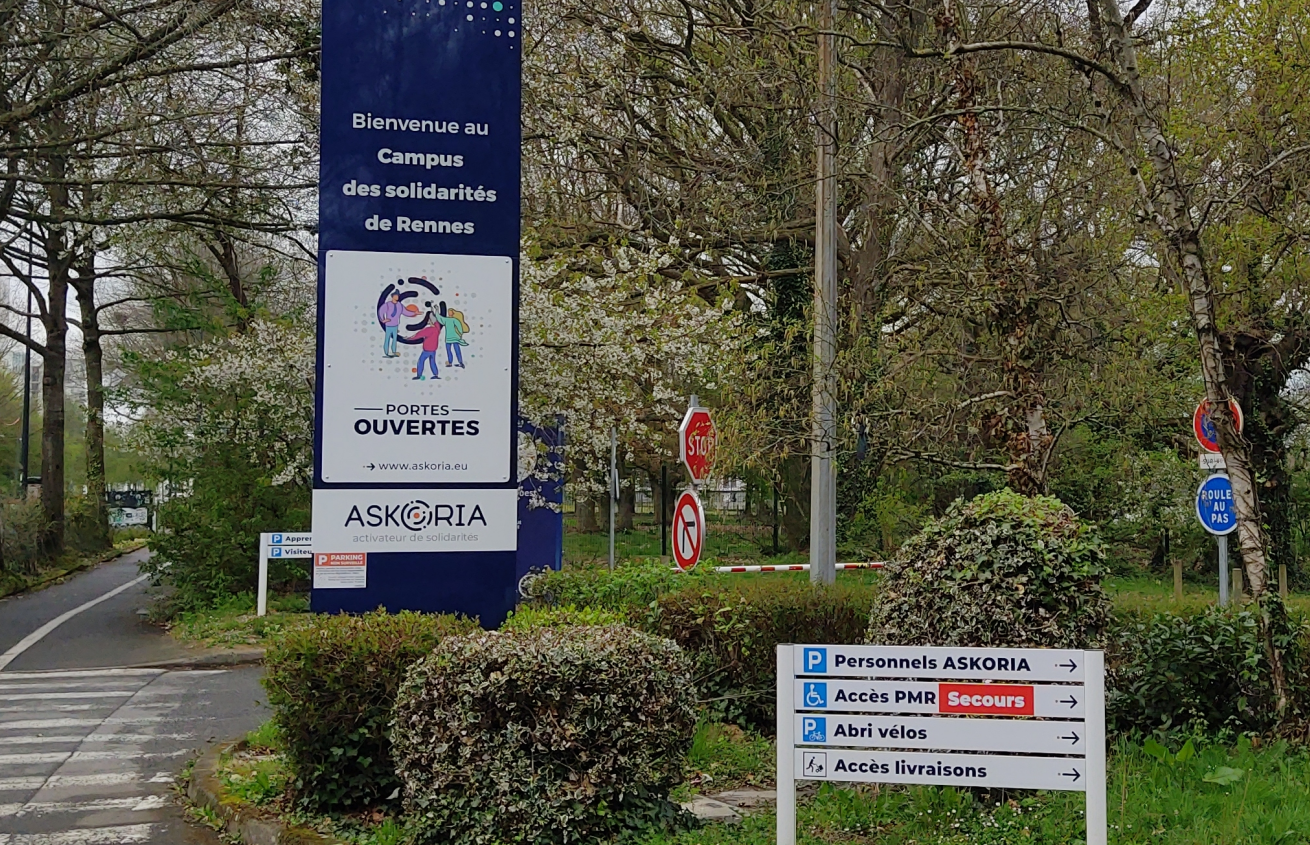
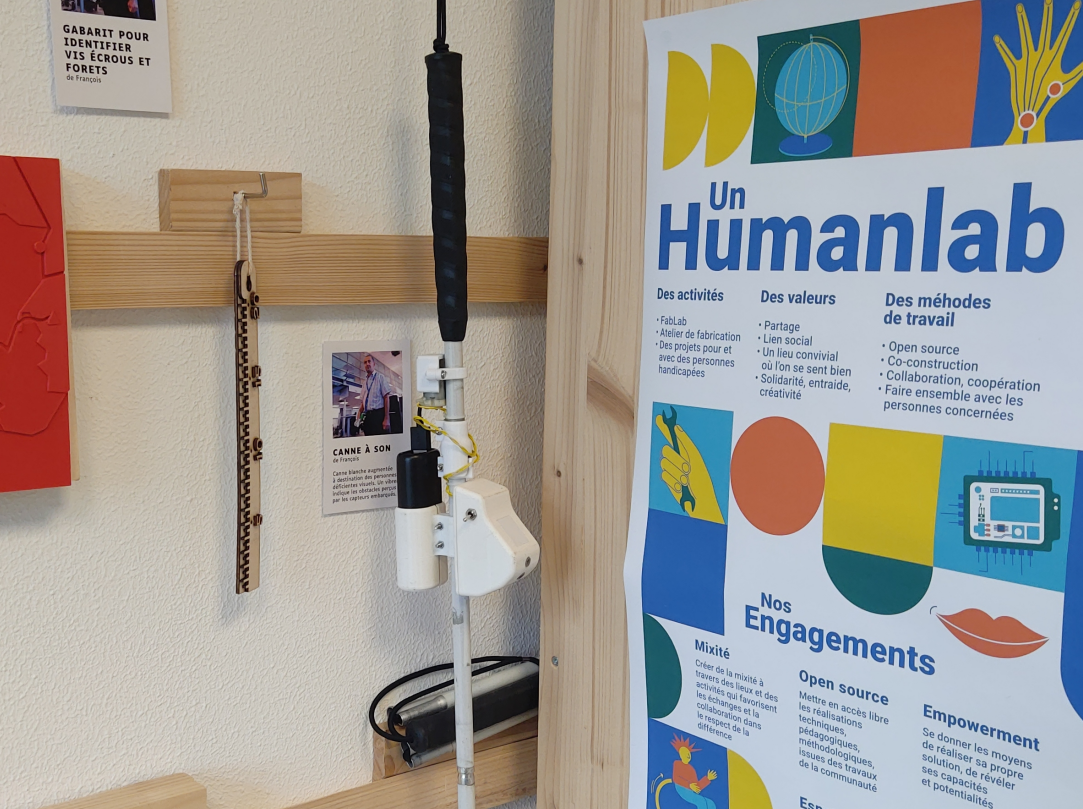
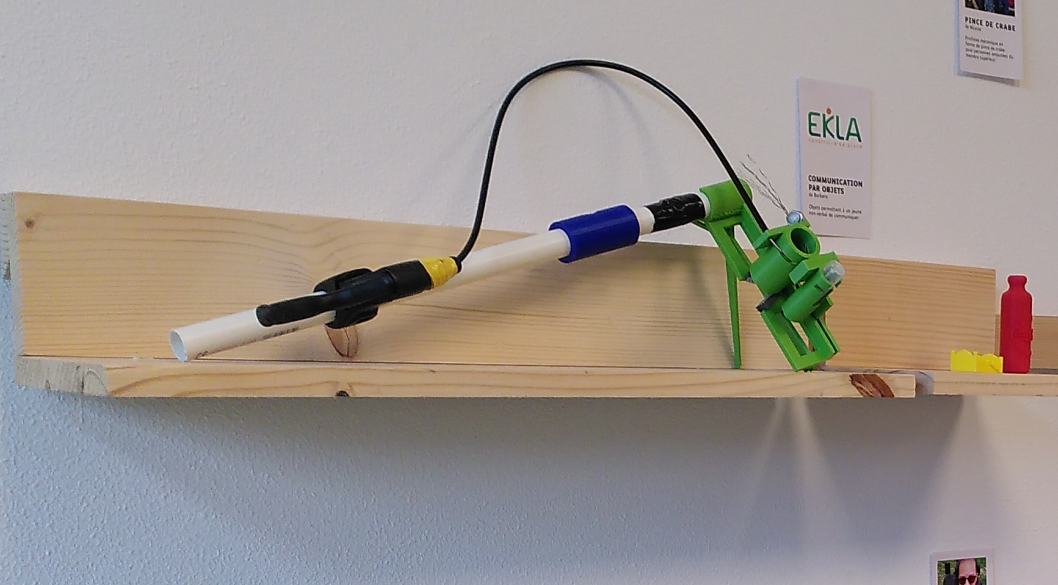
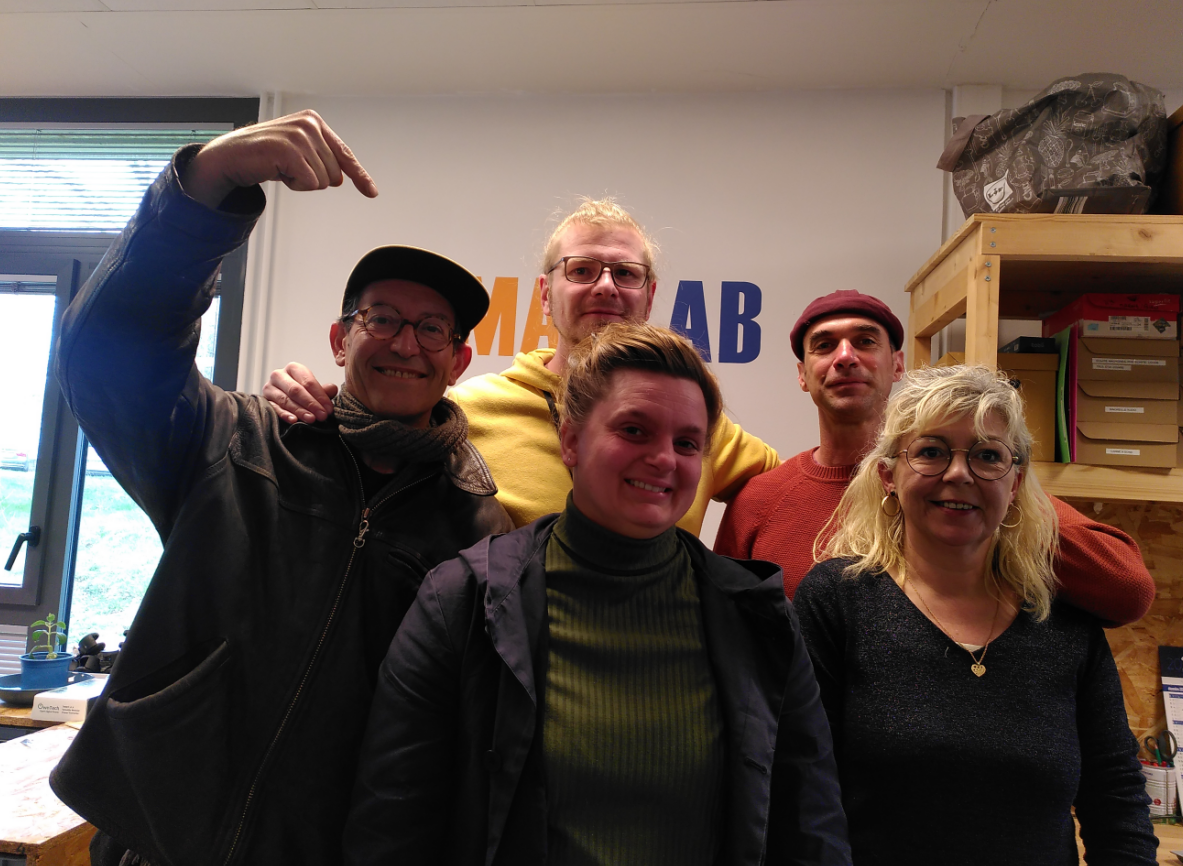
Evidence photo^^
2. Lab visit - Art Academy EESAB (École Européenne Supérieure d’Art de Bretagne), Rennes
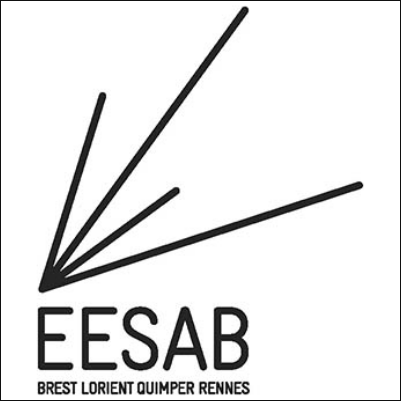
After a short lunch break in the city center, we continue to the EESAB. We have an appointment there with Amélie Tehel, Romain Chefdor and Celia Guye. Amélie is Managing Director of the RFF Labs Network since October 2024, in which Romain and our friend Alexandre Rousselet are also active. Romain is also active in a coordinating role between the city's LabFabs - so he is also very familiar with My Human Kit and the EESAB. Celia, on the other hand, is a designer and LabFab manager at EESAB and is also involved with MHK. We quickly realize that a lot of people here are working closely together and are motivated.
We get into a deeper conversation about our travel intentions and learn a lot about communal cooperation in the workshops of the city of Rennes. A tour of the diverse, separate and well-equipped workspaces for the students (and every Tuesday for the general public via an open workshop) for laser, wood, metal, CNC, letterpress, gravure printing and ceramics concludes the visit.
LabFabs? What is that?
The city of Rennes has a specialty in its city: a large and at the same time one of the oldest associations of local workshops, which all come together to form the Rennes LabFab network. Currently, there are already 26 different locations spanning the network. The advantages for users are a good overview and accessibility, low-threshold access and good communication with each other. A map also shows this online:
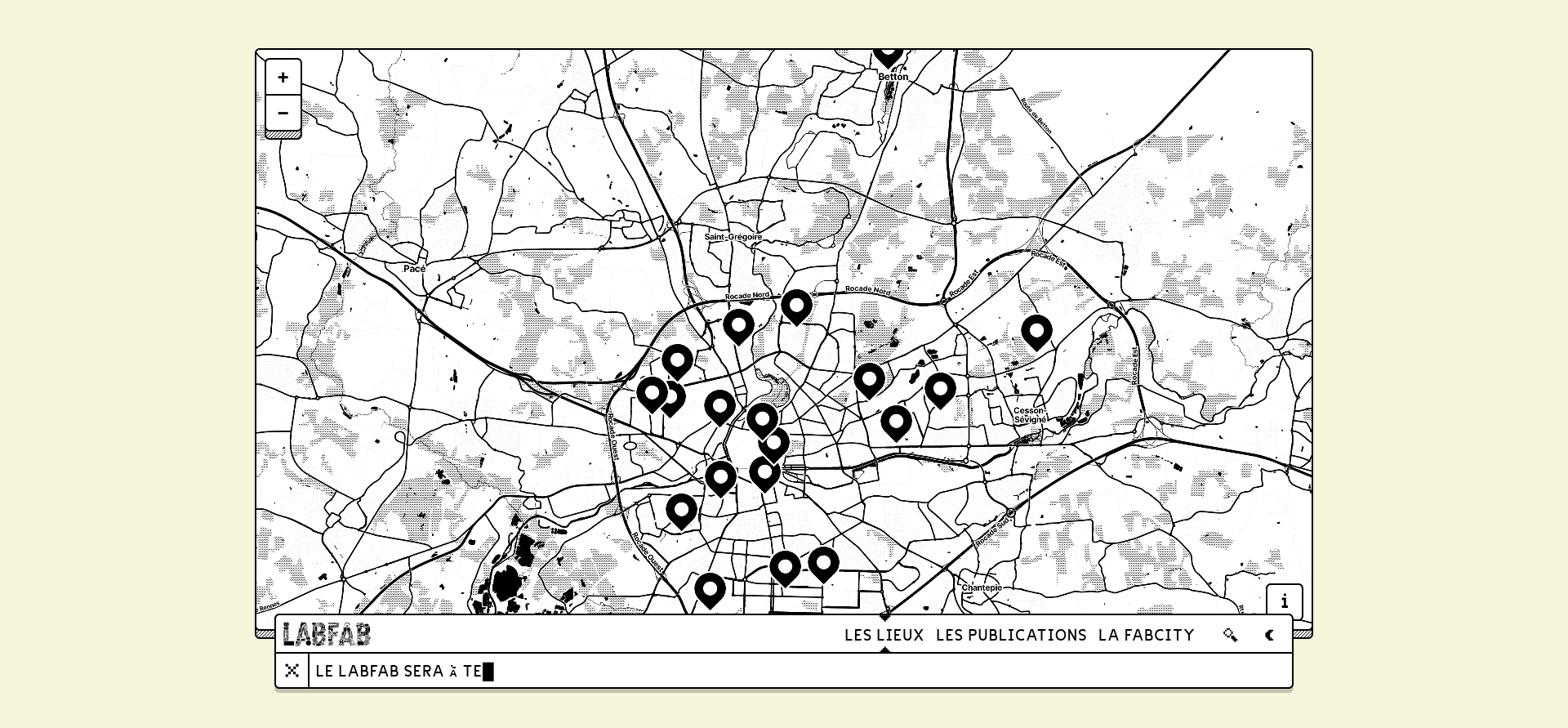
FabCity? What is that?
We also learned from Romain that Rennes is a FabCity - just like Hamburg. Brief digression: the FabCity movement was launched in 2014 at the instigation of the Barcelona FabLab and brings together territories from cities to regions that collaborate on an international level to design and prototype new resilient city models based on the practices of FabLabs, among others. The FabAccess project, in which we are involved within our association, was also linked to the FabCity Hamburg project “INTERFACER”.
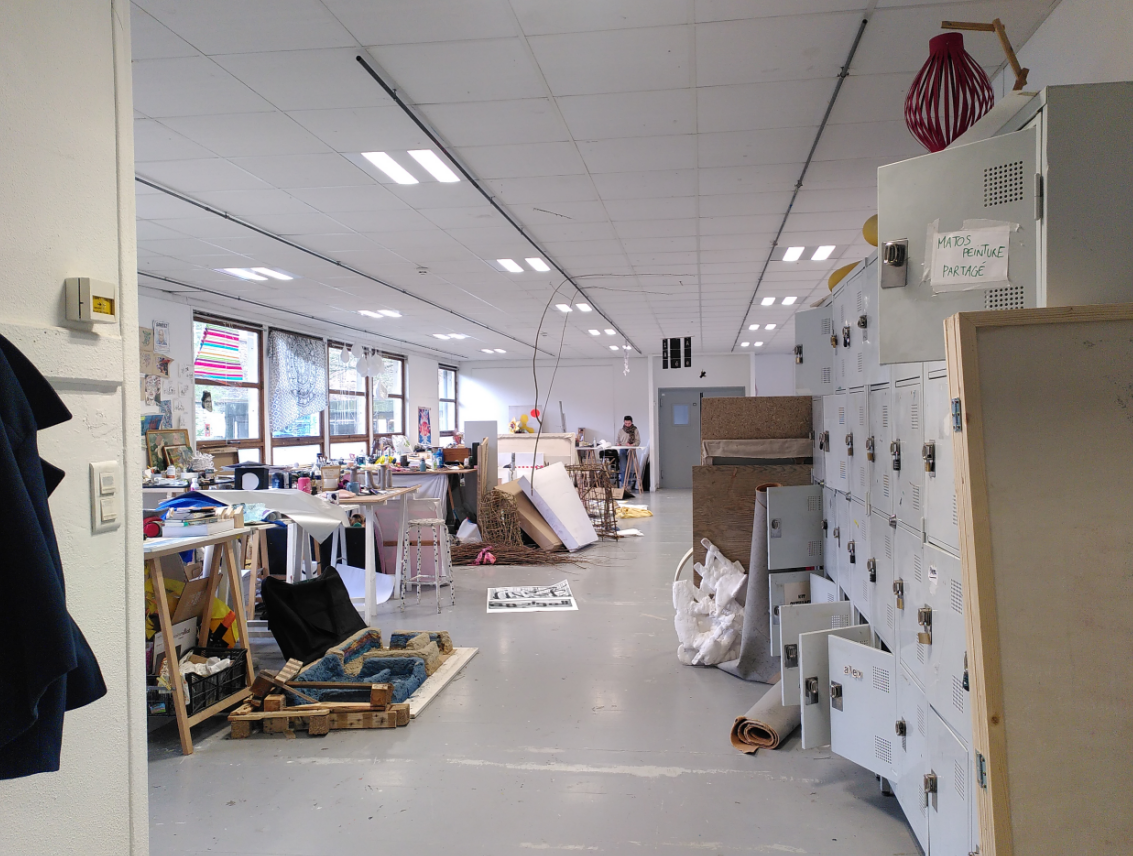
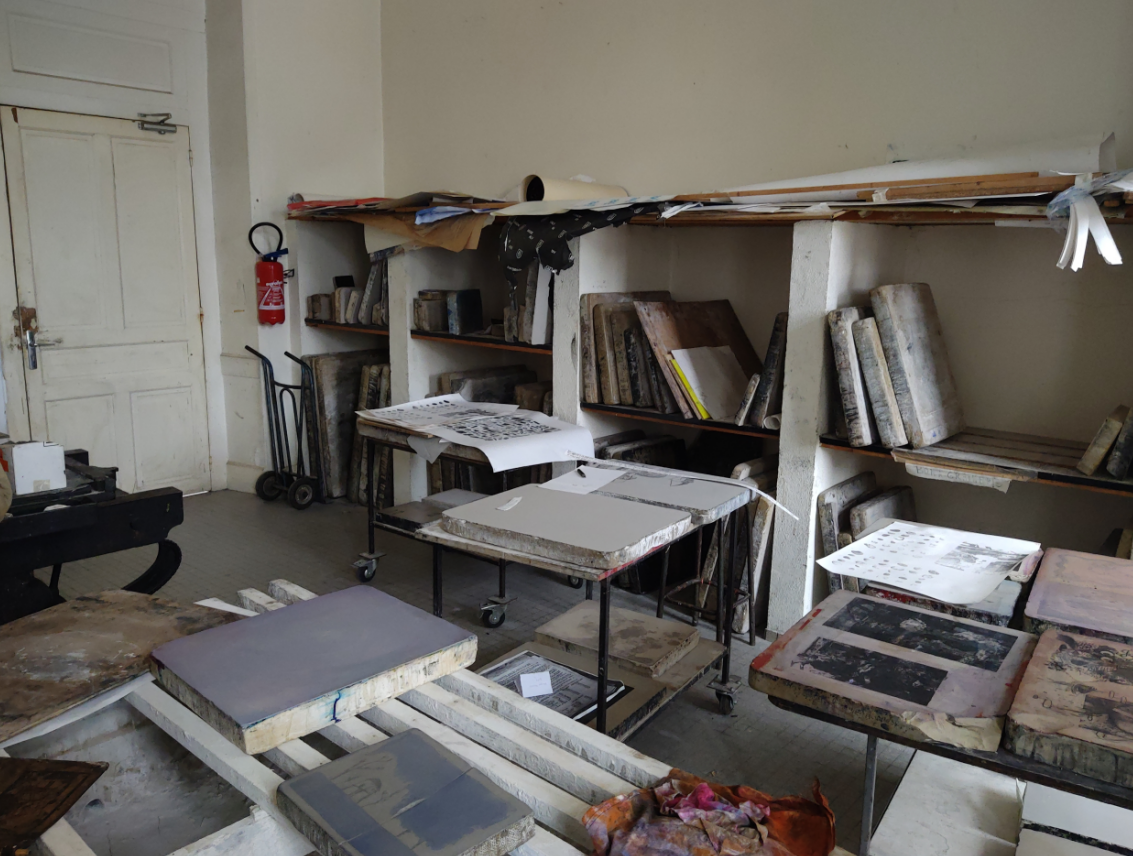
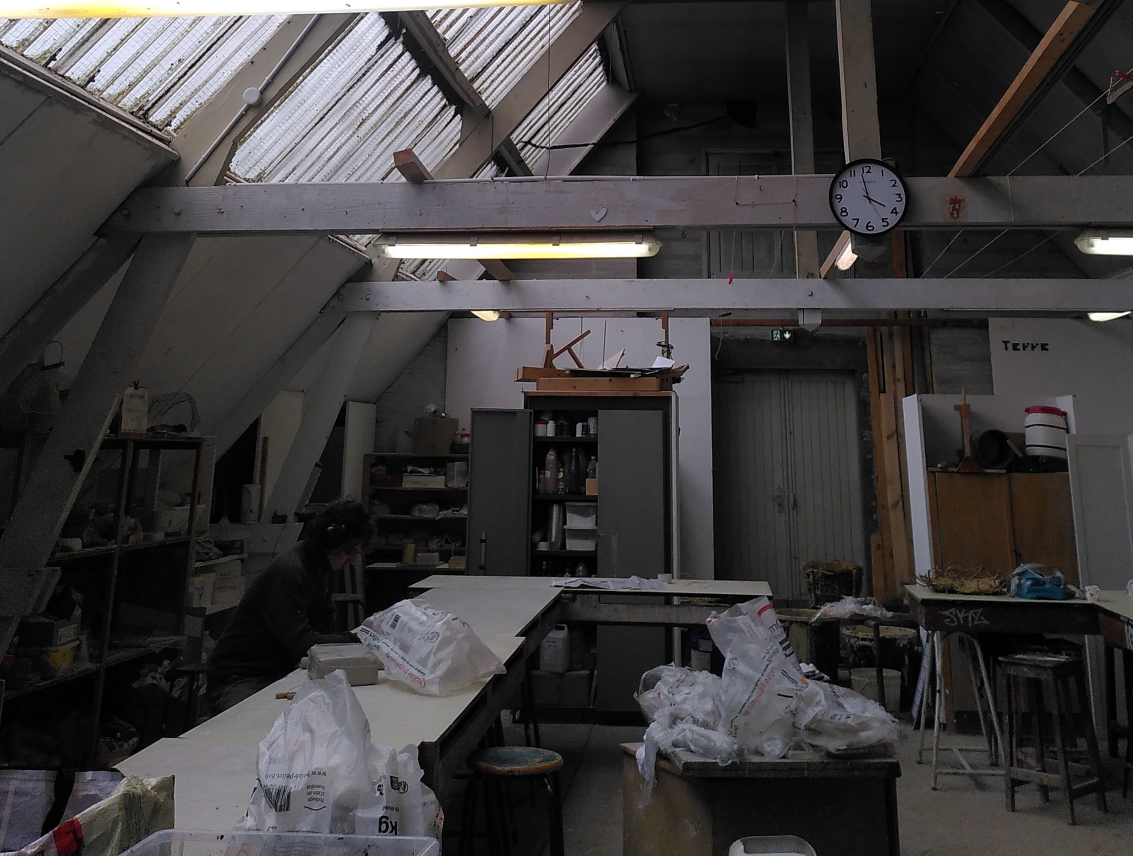
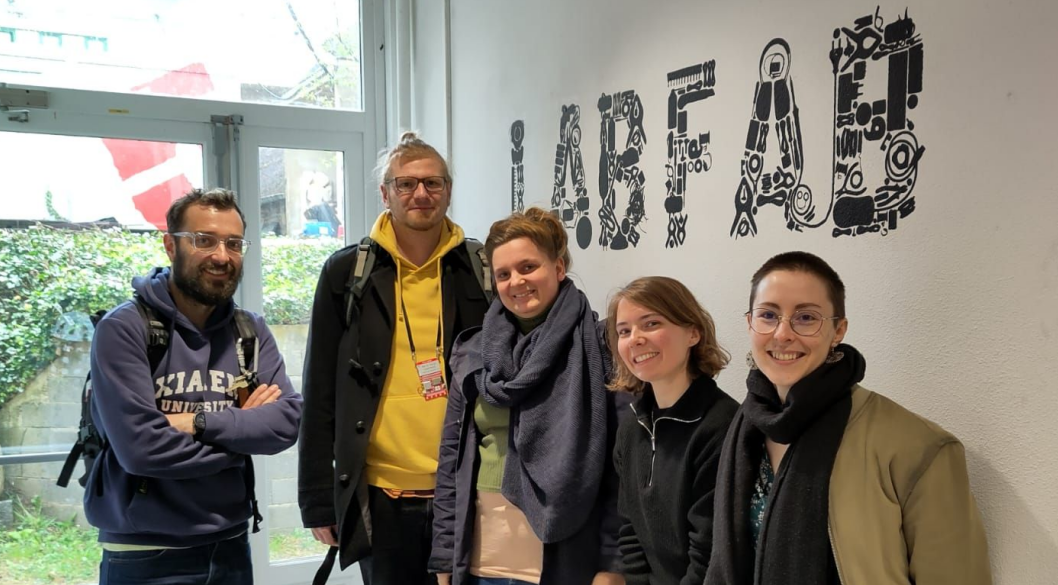
3. Lab visit - édulab Pasteur, Rennes
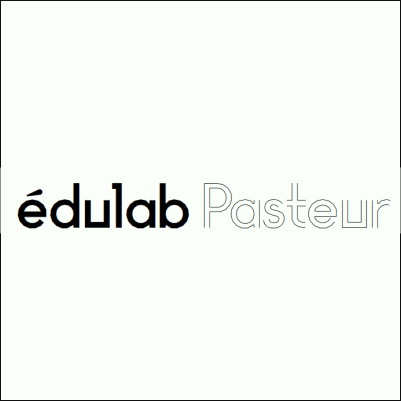
Our last visit to Rennes takes us - together with Amélie and Romain - to édulab. This is a makerspace for students and young people in a large, historic city center building (it used to be a dental school) that is run by an association. The utilization concept was initially developed and implemented together with residents of the city.
There is an elementary school on the first floor.
On the second floor there are lounges, co-working areas, swap stations, a library and a chill-out zone.
One floor further up, there are studios where people can rent space for a specific project period (free of charge). There is a sign on each door indicating whether the studio tenants can be visited and exchange ideas with interested people or whether they want to continue working undisturbed.
On the second floor there is a gallery (free exhibition space) and a roof terrace with an open kitchen where people can cook and eat together.
Finally, the édulab is also located here. This is a small, clearly structured lab with a room for green screening, video production and an integrated podcast studio. There are also workshop rooms for things like education Lego and Makey Makey. Creative techniques with an embroidery machine, RISO printer that imitates screen printing etc. are also a unique selling point. The édulab is a place made especially for children and young people.
Our visit was a great experience. The place was buzzing with life from the ground to the top of the roof.
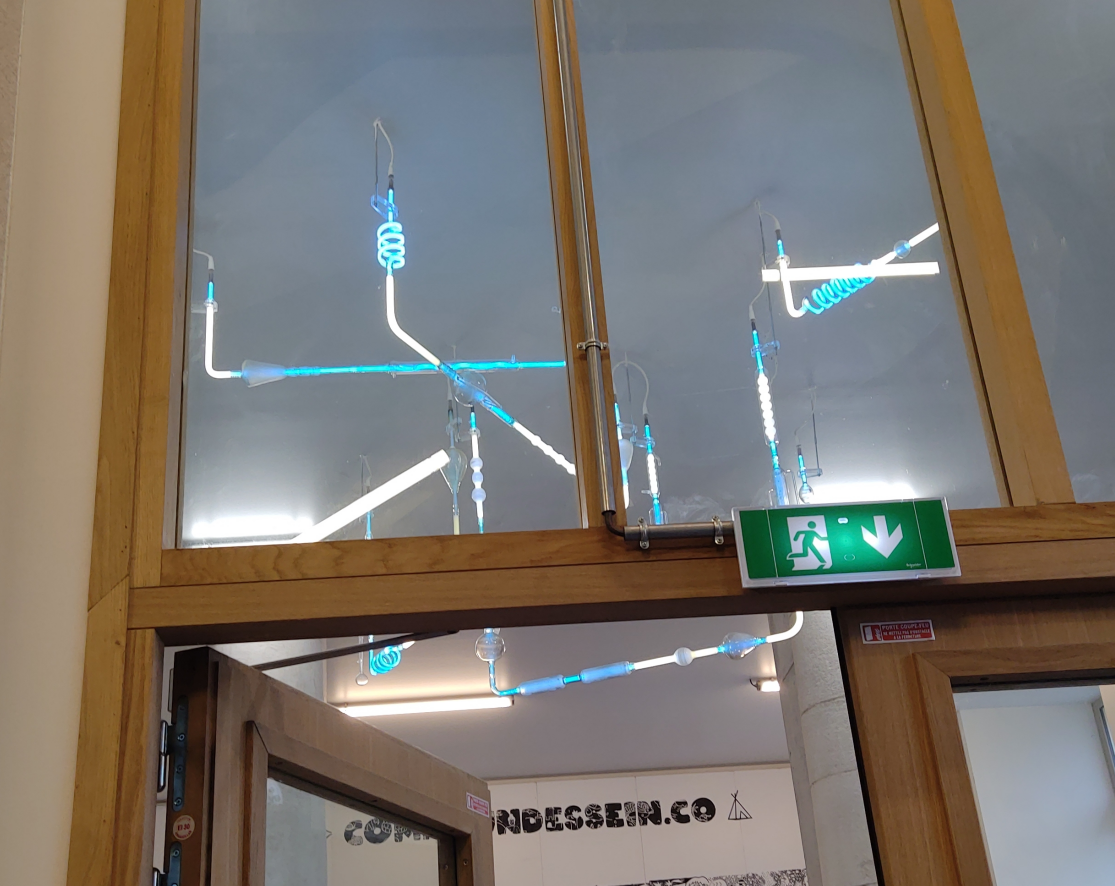
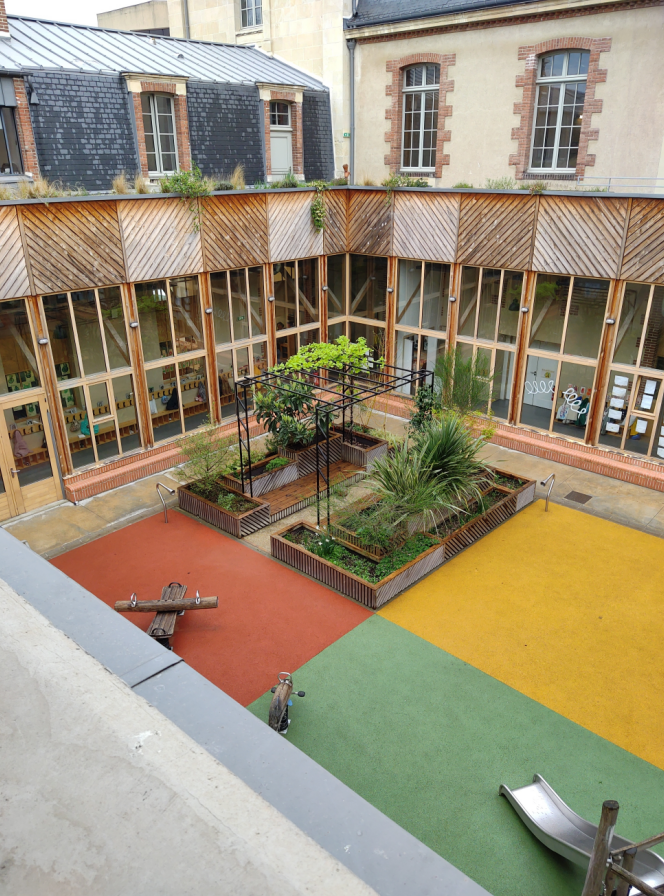
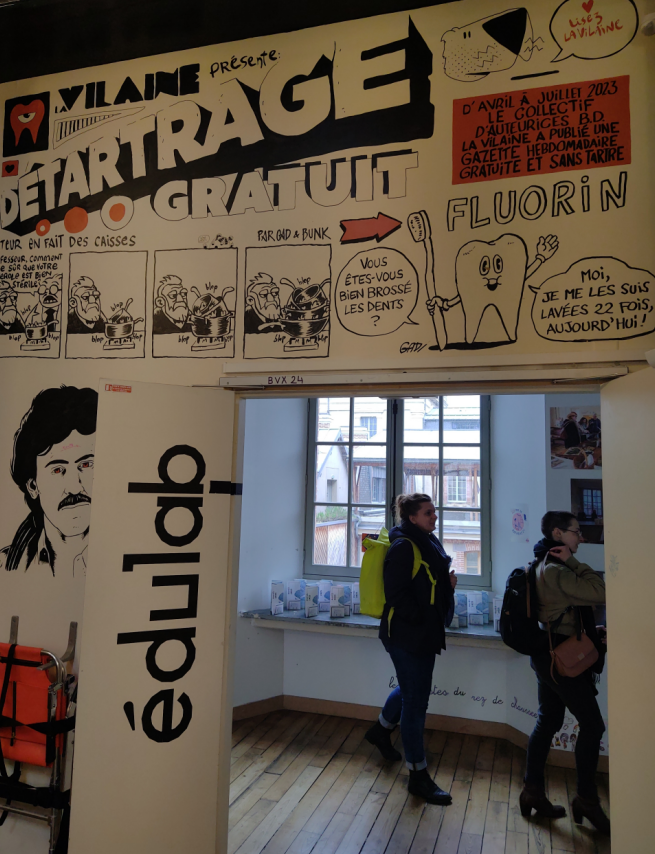
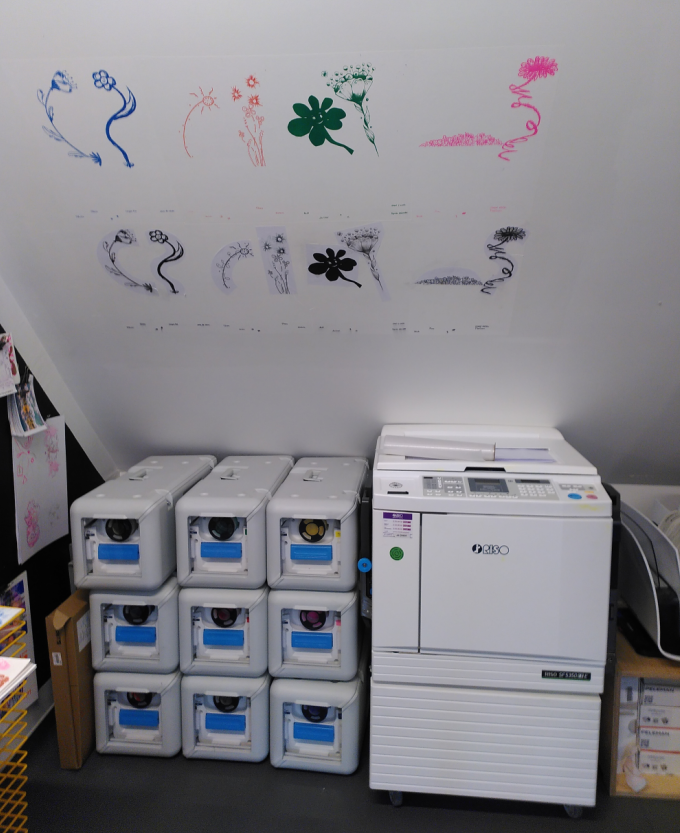
A 360° tour can be viewed here (from November 2024 - Axel was there before us!).
Finish at the Bistrot Lab in Coësmes
The day consisted of a lot of input intake and attentive following, conversations, translations, sorting and note-taking and lots of socializing. It left our heads spinning. Fortunately, we were able to compensate for this by spending an evening with Hugues at the Bistrot Lab in Coësmes. Hugues, who had recently discovered the adventure of getting a Morrad driving license and riding a motorcycle, invited us for music and food in conviviality and drove to the village about 30 minutes away from Janzé. We drove there directly from Rennes.
The Bistrot Lab is an association-run meeting place for making music together, with a small bar and for various events and exhibitions on the upper floor. It was founded after the coronavirus crisis, when the town no longer had a single store for its residents and initiative was needed. The locals now meet here regularly and take responsibility for running the place and moving it forward. Highly recommended!
Friday 04.04.2025
4. Lab visit - La Fabrique (La Canopée), Janzé
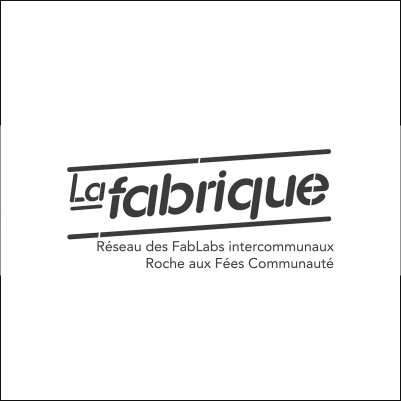
Wake up!
Unfortunately, we woke up on the last day in Janzé and started the day a little hectic and with Crossaint in our mouths, while we were already halfway to the Makerspace La Fabrique because we had overslept. Fortunately, “La Fabrique” is only a 5-minute walk from Hugue's house and can be reached quickly on foot in good weather. It is a space that is integrated directly into a communally run building (“La Canopée”) and translates as “leaf canopy” or baldarin. The operator is Roche aux Fées Communauté (RAFCOM). In addition to the makerspace, it also offers other aspects, such as a coworking space, a shared office, a work consultancy, a small library and an open space (for events and exhibitions).
As soon as we arrive, we meet the two Fab Managers Pierre Sesia and Sam Rocheron alongside a group of young people who are doing a workshop. They show us around their area, which has many important and typical elements of a makerspace, such as 3D printers and laser cutters, a Precious Plastik line, an embroidery machine and tools for electronics, as well as various project parts from the Humanlabs. Here we discover exciting things such as electronically controlled prosthetic hands, a life-size humanoid DIY robot and the BrailleRAP, among others.
BrailleRAP and CCLab
This is how we finally come into contact with Stéphane Godin. Stéphane is the software maintainer behind the BrailleRAP. This is a machine that can convert various graphic formats/files into Braille patterns via prior post-processing. In this way, visually impaired people with explanations can feel various shapes much better. This tactile experience makes it possible, for example, to feel the shapes of plants, a child in the womb or various hiking maps or even a Paris subway map. BrailleRAP was developed by Hugues Aubin, among others, and is actively maintained. It is part of the Climate change Lab initiative, of which Hugues is a member.
The Climate Change Lab (or CClab) connects the local with the global: The Climate Change Lab's formats bring together people who are far apart and come together locally to make progress. It is a utopia, a team, a community of sharing and cooperation, a forge of formats that combine pedagogy, prototyping and international cooperation.
The BrailleRAP project has a dedicated website and is open source hardware. It's essentially a plotter that uses an electromagnet to emboss non-hemispheres (Braille dots) into paper, taking into account important parameters such as depth, diameter, and spacing. Stéphane explains some aspects of the software and also shows us the various sub-programs and GitHub sources.
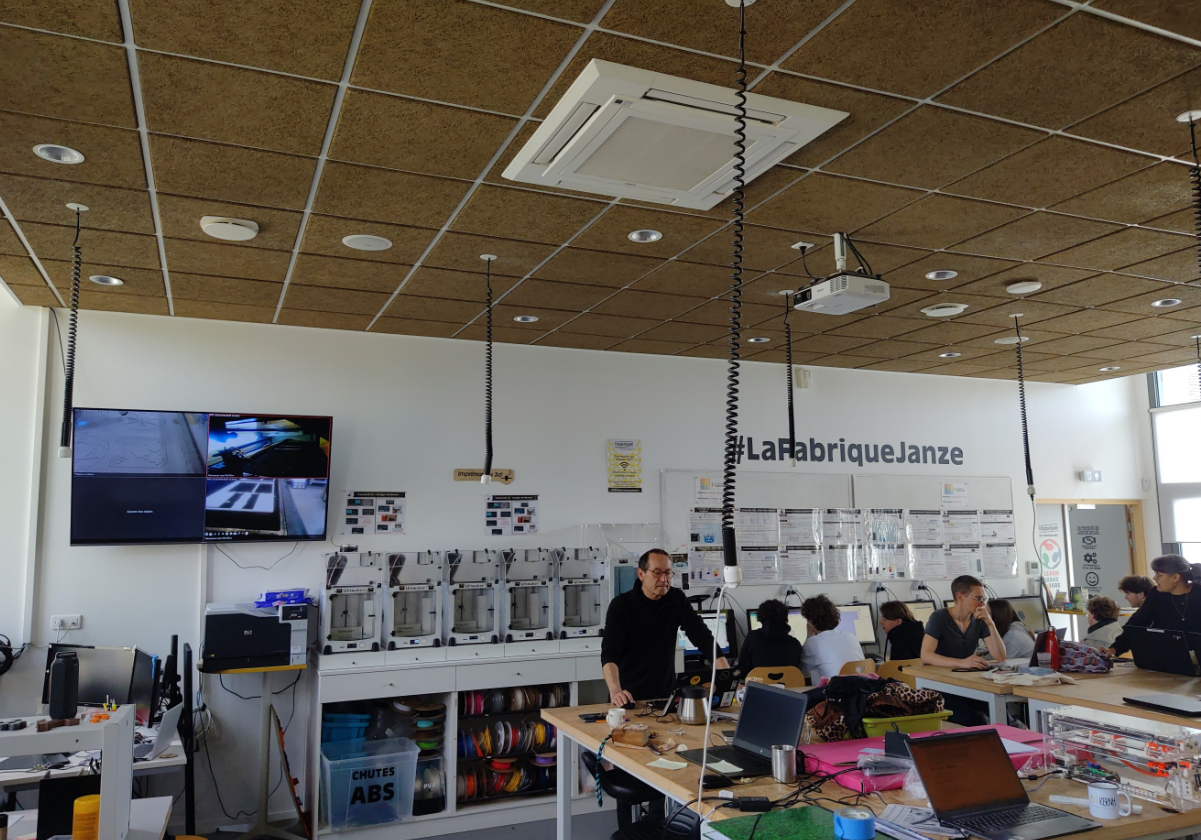
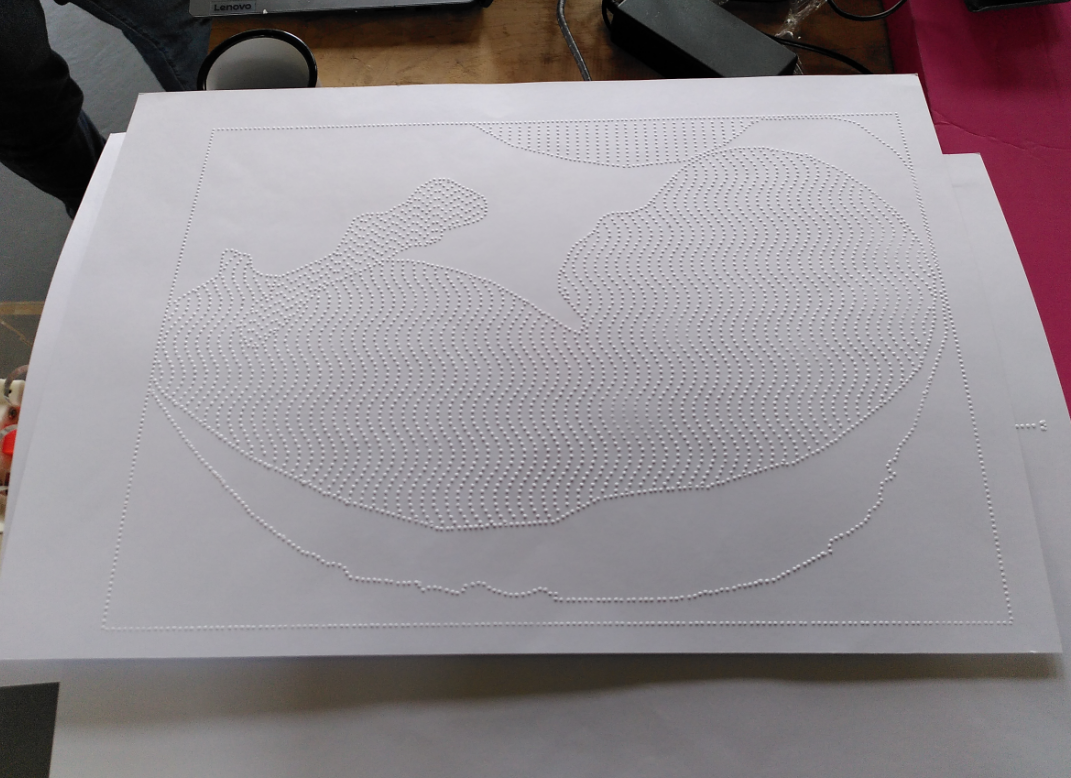
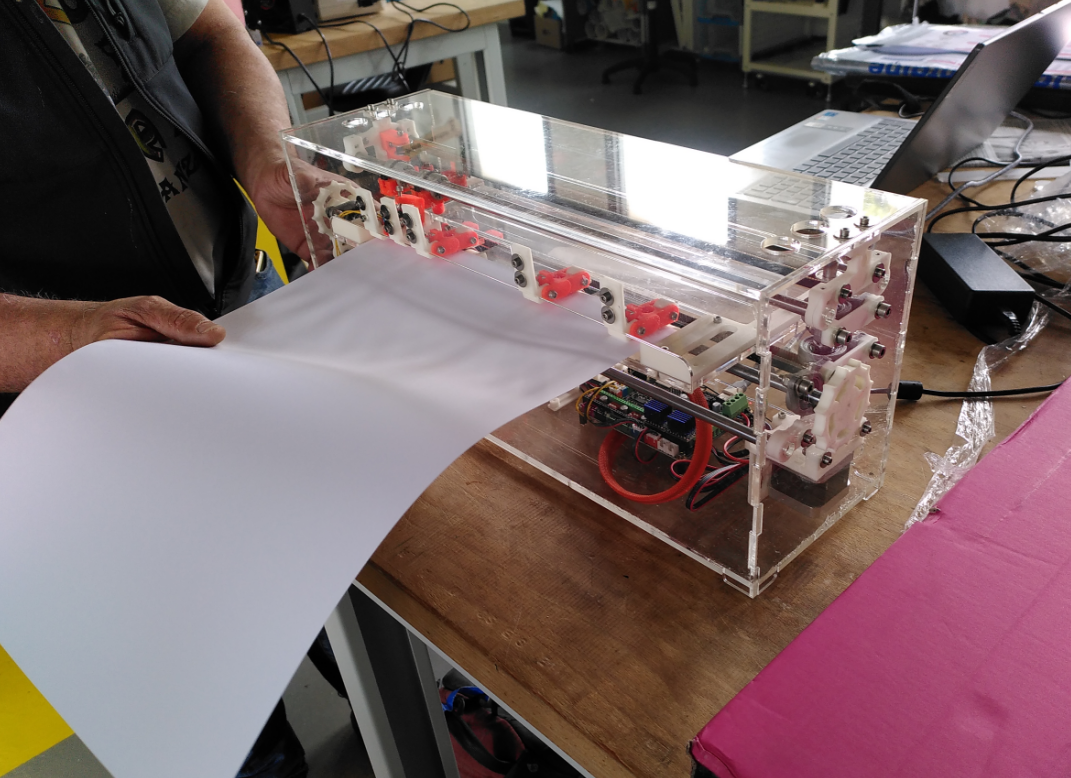
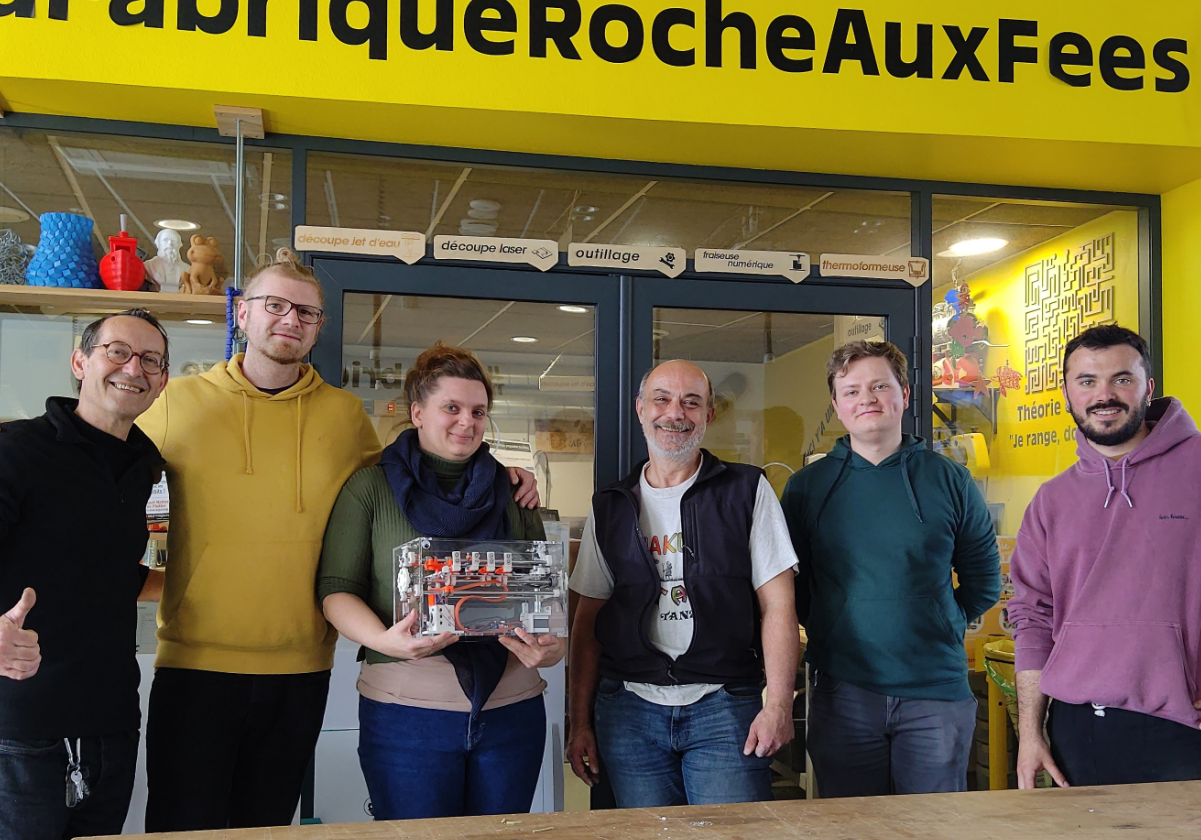
Farewell and onward journey to Nantes
After spending the whole morning at La Fabrique, we worked up an appetite and went for a few galettes and lemonades with Stephané and Hugues in a quaint créperie. Afterwards, we had a 2-hour meeting with Mathieu Rietman from near Brest, who will be one of the next stopovers on our trip.
Finally, we went to Hugues' old backyard garden, where we stroked the chickens with coffee in hand while Hugues and Stephané dug out their long-standing project that they had announced in conversations: Making music with plants! Together they have developed an Arduino project to connect sensors to plant parts and convert biosignals into digital signals. They then use these signals in the Midi protocol to combine and play back various instruments and effects. The result is a harmonious sound construct, in which the gifted electro music maker Yohann from My Human Kit sometimes gets involved. As soon as they turned around, the sensors were already attached to a palm tree and the app was unpacked. They tell us that they regularly perform with it and have even orchestrated in the Philharmonie. In recent years, they have supplemented the whole thing with light installations on plants and turned it into a very special experience.
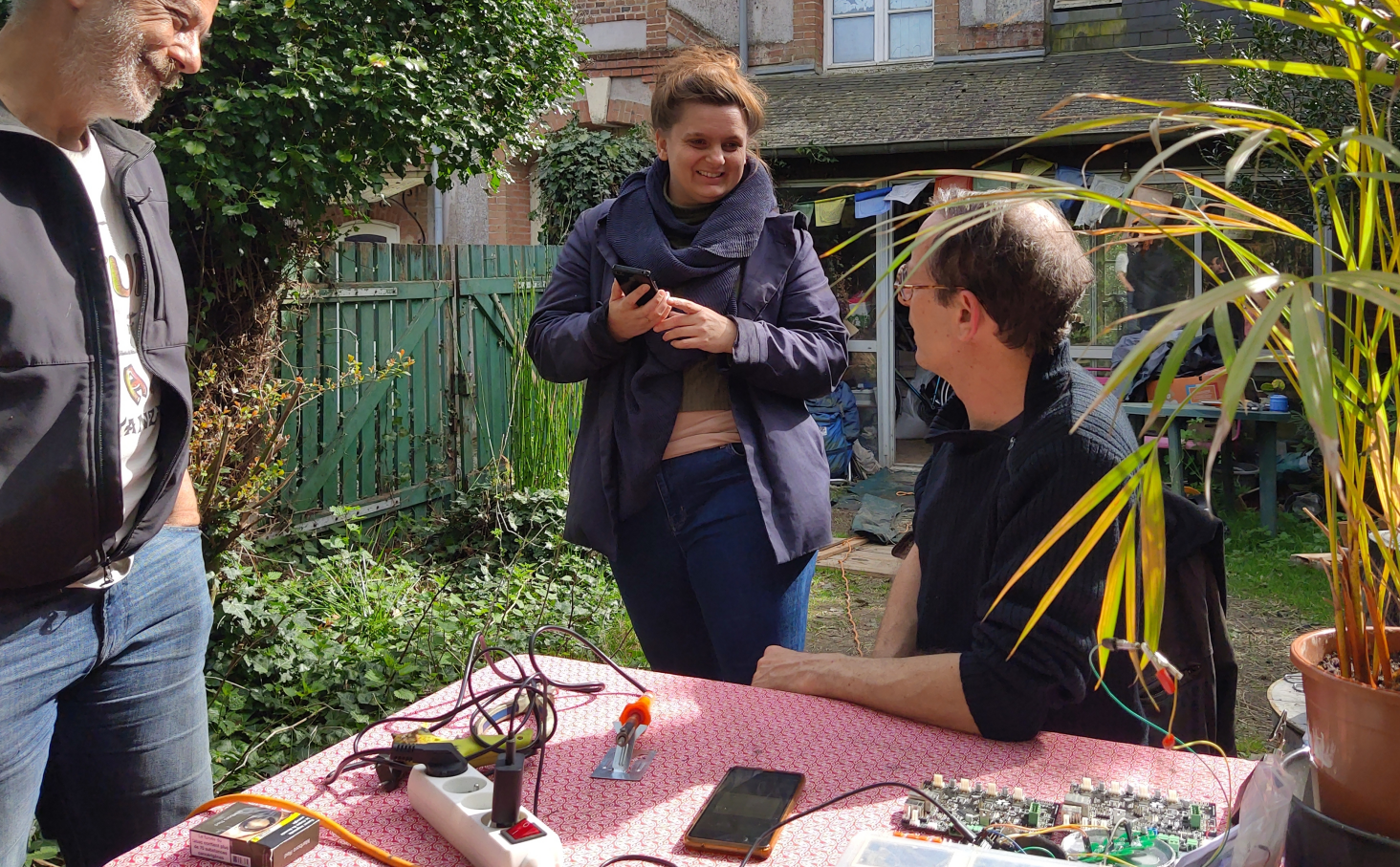
A small example of what a geranium spits out, on YouTube, or here.
Unfortunately, we then had to interrupt the sunny afternoon and the conversation to continue our tour. Next destination: Nantes. We arrived here in the evening and stayed with old friends of Mario.
Saturday 05.04.2025
5. Lab visit - Blue Lab (in le paquebot), Saint-Nazaire
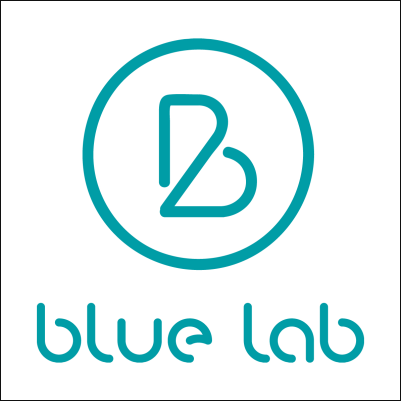
The Blue Lab, also a member of the Vulca network, is located directly in the city center of the large port city of Saint-Nazaire (approx. 71,000 inhabitants). Parking spaces were correspondingly scarce.
Until recently, it had been closed for six months for renovation work. When we arrived, however, there was already a lot going on again. The Blue Lab is located on the first floor and offers workshops for CNC woodworking, lasers, electronics, 3D printing and more. They also run a 500m² co-working space called leSPi in the same wing of the building.
Just arrived, we meet a wide variety of people: Among others, the Lab Manager Damien Henry, who welcomes us. A few seconds later, we also see Emmanuelle Saunier and her companion, whom we met last year at ZAM Erlangen, and immediately realize that it's a small world.
As soon as we started talking about the ZAM, our travel companion Axel Just joined us, who we will be taking with us on our tour for a few days from now on and who unpacked his equipment to take a 360° photo shoot of the workshop (VR tour). Axel has French roots and is an advantageous intermediary when it comes to translating (technical) things back and forth in French, English and German.
As we walk through the rooms and talk about our journey and intentions, the room fills up with more people, as you would expect in an open workshop.
Jonathan Winandy (Board Member) is one of the people who explains to us, among other things, that the Blue Lab regularly offers an open workshop specifically for people with disabilities. In contrast to normal “open workshop” times or repair café offers, the focus here is on the needs of people with visual and mobility impairments, for example. During this time, this is where all the attention belongs. For example, we look at whether it is possible to produce special brackets for wheelchairs in a short space of time and with manageable effort to reduce everyday problems, or we look for suitable concepts.
Jonathan also explains to us that there are things that we don't always think about in everyday life: epilepsy or, for example, the increased perception of flickering images from monitors and other display devices. There are sensitive people who have major problems with this and who become tired or ill more quickly or lose concentration as a result.
Another exciting aspect is the joint instructor and course work. The Blue Lab successfully integrates people with disabilities into workshops by developing a sensitive approach and responding to their needs from the outset. A course is therefore not a standard 0815 construct, but individual. The Blue Lab also regularly works with the long-term unemployed.
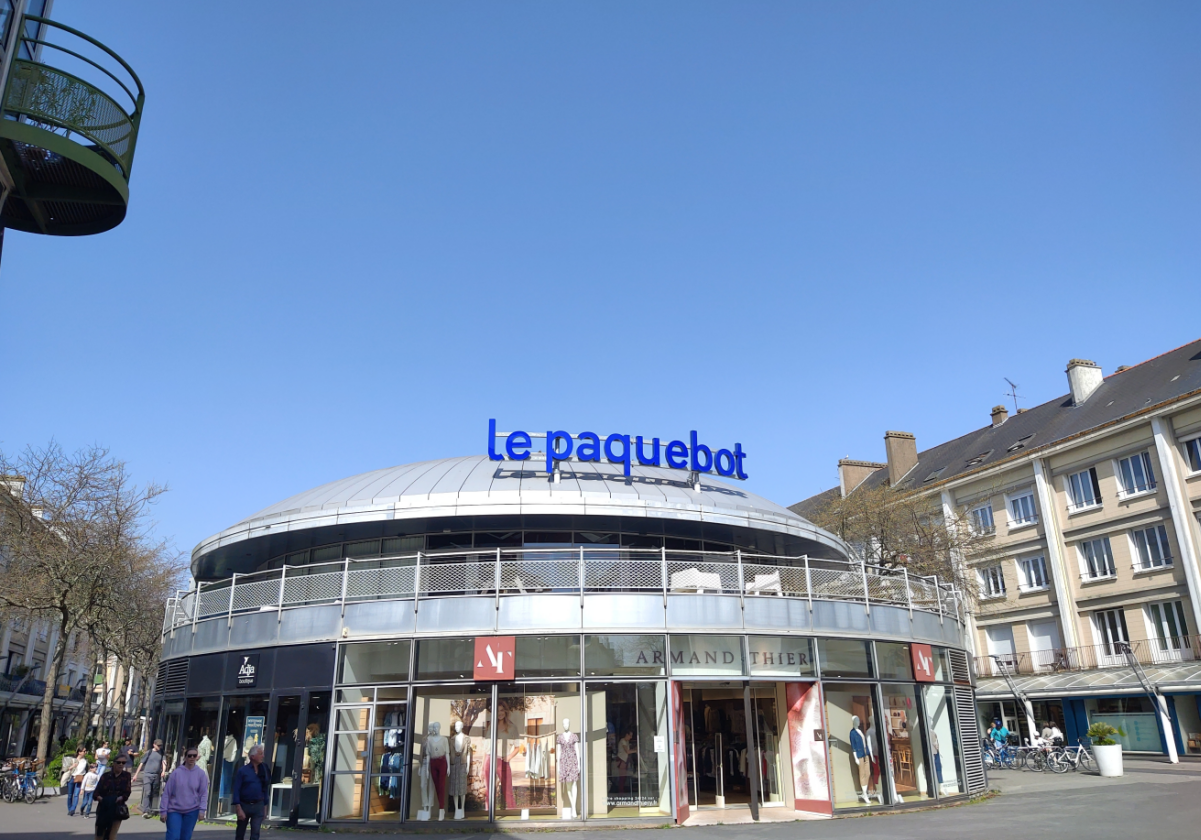
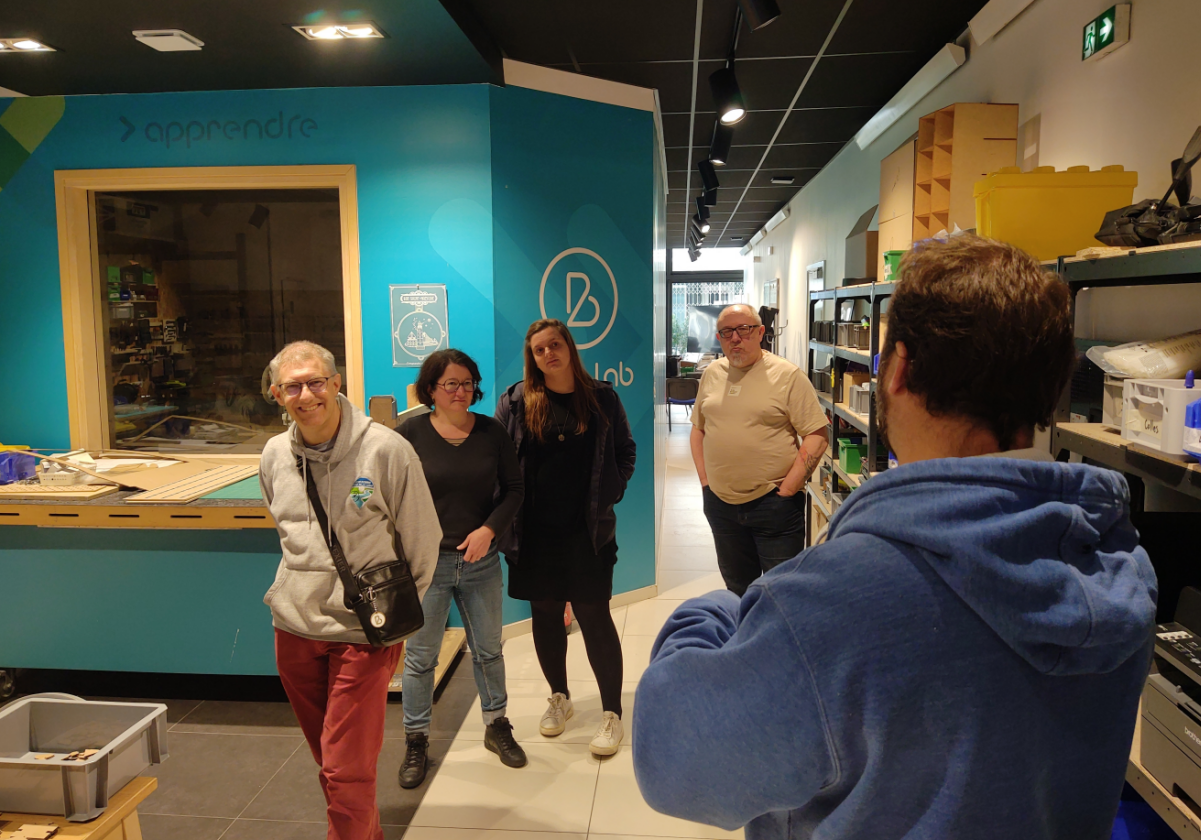
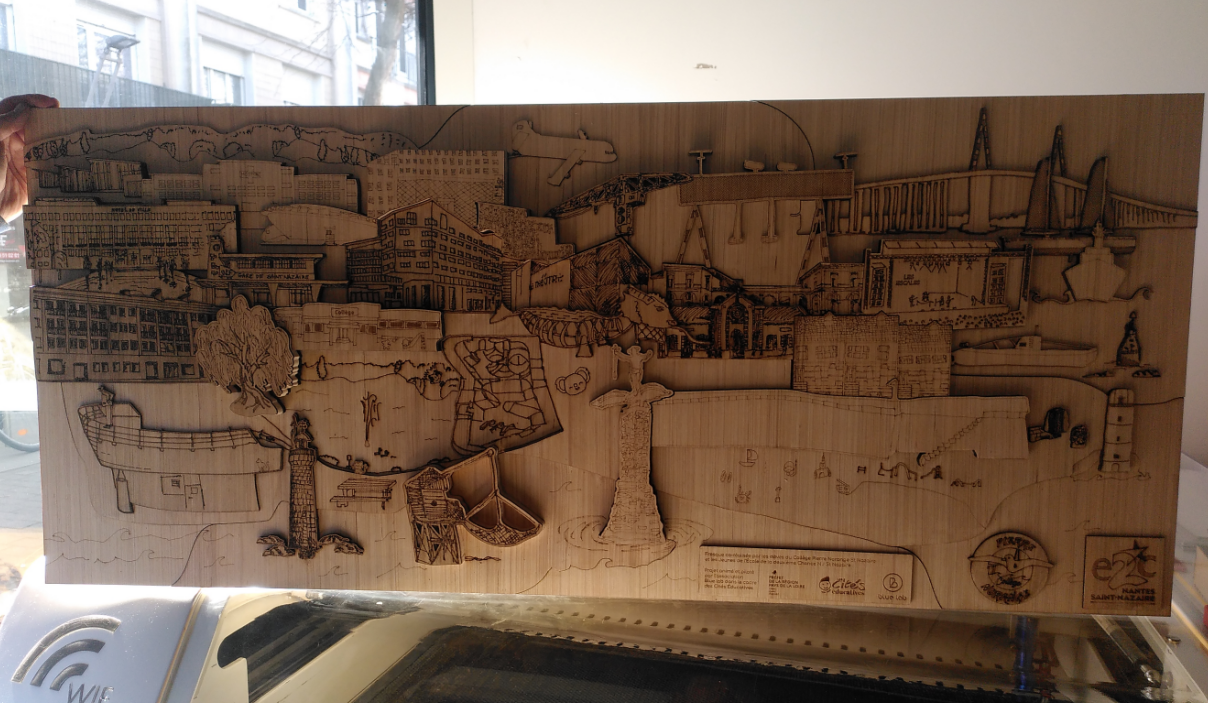
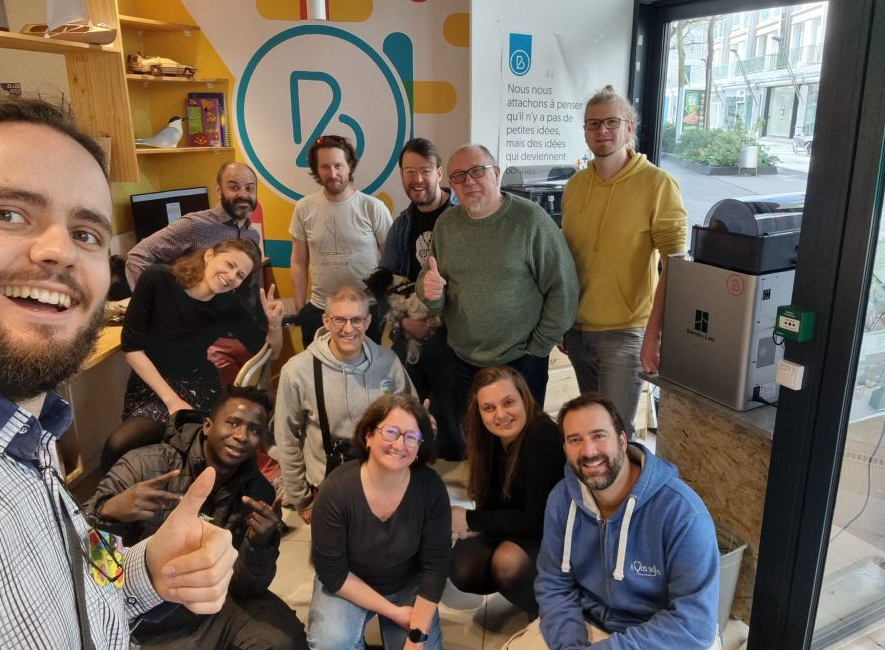
A 360° tour can be viewed here (this is an older one - Axel was there some years ago!).
Christophe Soula from the Blue Lab Board and Estelle will round off the day with us. We drive together to an old submarine lock in Saint-Nazaire and to ancient salt fields in Guérande. We also make a little detour to La Baule. This is the place where Axel's grandma lives and is also known as the “Sylt of France”. It is a place with very old, tranquil houses and forests. Unfortunately, dozens of hotels have been built on the coast here in recent decades and are now feeding mass tourism. The evening then ends back with our friends in Nantes.
Sunday 06.04.2025
The weather is good and the day is not planned with work. With friends in tow, we walk through Nantes and visit Les Machines de l’île, among others. It's a great day out exploring in the best weather.

Monday 07.04.2025
After a day off, we set off for Saint-Nazaire on the morning of April 7. We make a quick stop at the Blue Lab to pick up Axel, who has come here from La Baule. Our final destination for the day is the city of Brest, with detours via Crach and Quimper.
6. Lab visit - UZINOU, Crach
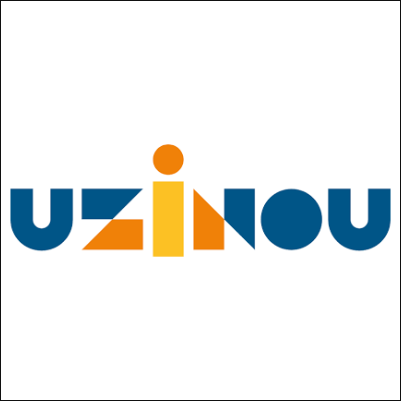
On the way to Brest is the small village of Crach (3,500 inhabitants). Here you will find a small community factory that works on sustainable products, represents social and ecological values and shares its know-how: The UZINOU.
Delphine gives us (Axel) a tour of the workshop. Here you can discover a large textile workshop and a Precious Plastic line. Here you can do everything from shredding to extruding and making sheets. We didn't have enough time for an extensive exploration tour. However, Axel has collected photos for a 360° tour.
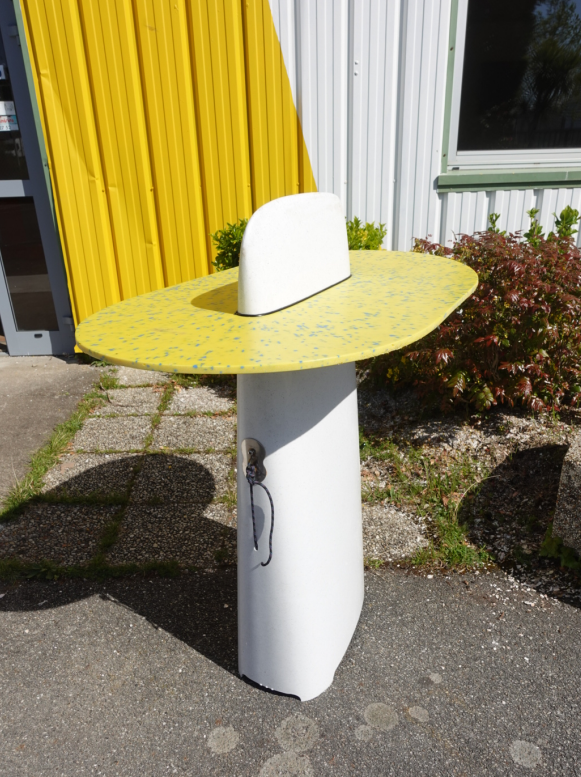


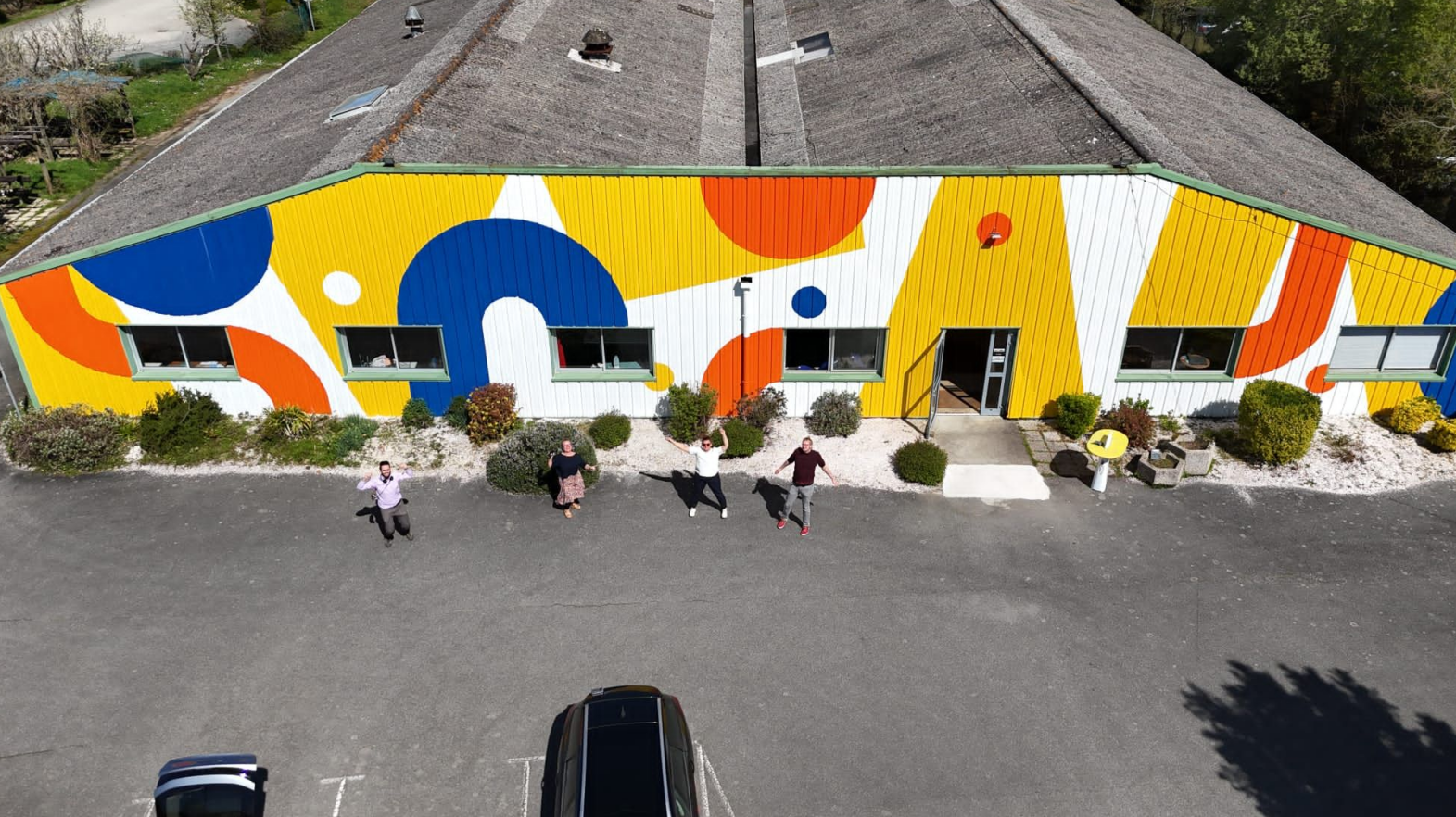
A 360° tour can be viewed here.
7. Lab visit - Flux / Les Portes Logique / Gwenilli / (Humanlab), Quimper
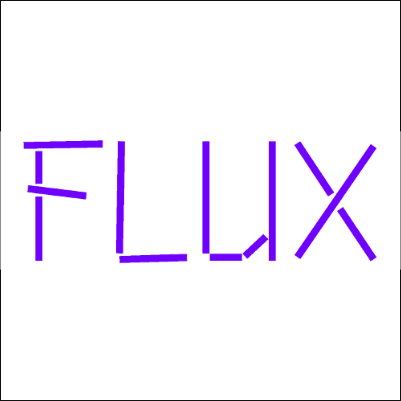
Unfortunately, we arrive in Quimper, which means “end of the world” in German, about 2 hours late.
Our destination is the Flux. This is a place that has undergone a lot of change. In addition to a large construction site, where a number of people have spent years creating a shared house to work and feel good in by completely renovating it themselves, there are various organizations that have come together here and inspire each other. For example, there are the hackers and makers from Les Portes Logique and the intercultural network organization Gwenilli, which promotes Europe-wide youth exchanges, among other things. Together, Gwenilli and Les Portes Logique have founded another association, which is also called Flux, just like the location.
Once we arrive at the location, Cathi Schilling from Gwenilli shows us some areas of her “third place”. This is the name given to places that offer a further space in addition to one's own home, school or workplace, for example for social interaction, a place to stay and a community.
Flux combines exhibition areas, a reading and music café, Humanlab, FabLab, Hackspace, studios, offices and co-working.
We then came across Laure Bouscasse in the Biohacklab (Hackspace). She is a hacker and textile designer and specializes in combining digital techniques with textile technologies. Here we discovered equipment such as knitting machines, 3D printers, laser cutters, electronics corners, retrofits, tufting and more.
Flux also focuses on inclusion. In Flux, the Humanlab area is being expanded and there are committed members who are making a difference here. The pioneer at Flux is Perrine, who we unfortunately missed out on. Among other things, we discovered a knitting machine that can knit Braille. There are also interesting prototypes such as devices that allow fingernails to be cut easily - for people who can no longer fully move their fingers or hands, for example, or who are missing important phalanges that simply prevent them from touching everyday objects in the usual way. Another exciting feature is a converted telephone that announces the club's services to blind people in a low-threshold and easily accessible way.
Flux focuses on manifestos on inclusivity, gender equality and the repair of technical devices. Related topics include feminism, diversity and a socially critical approach to technology.
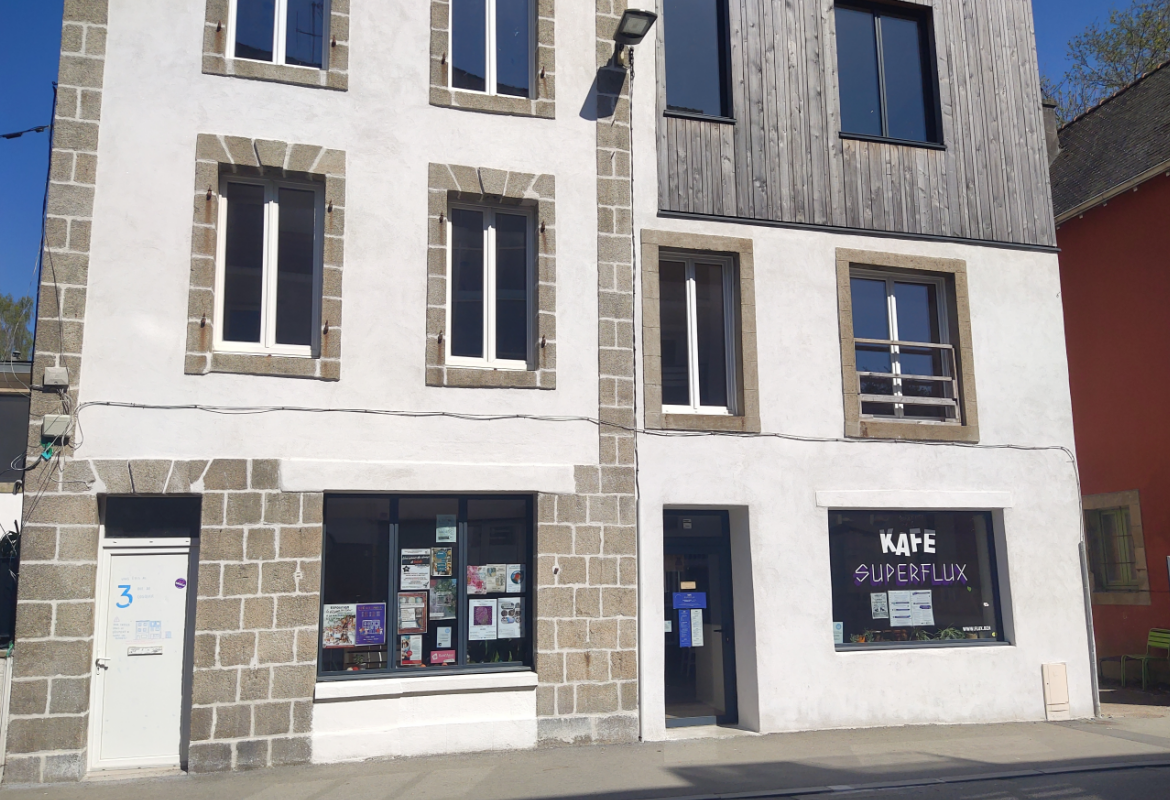
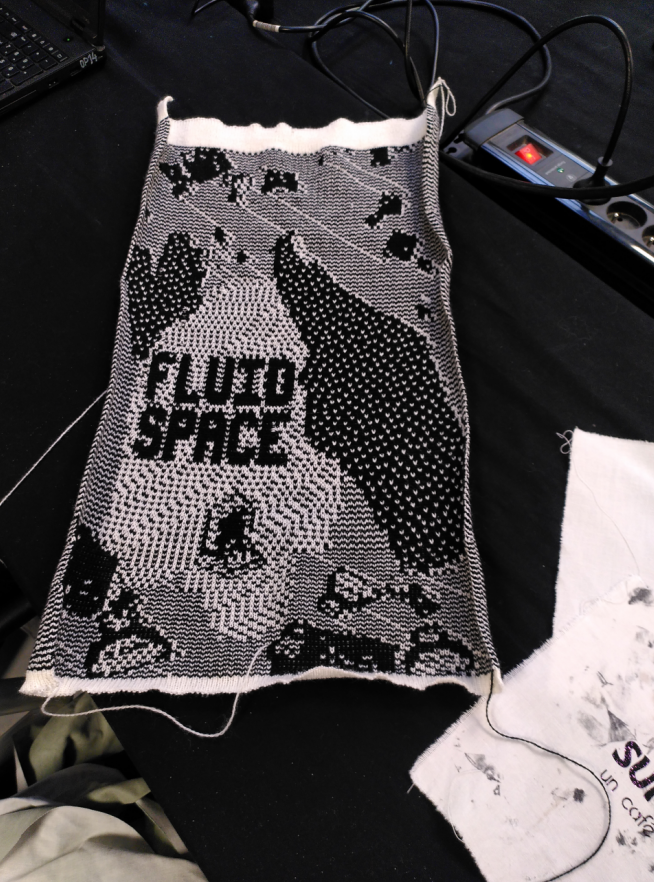
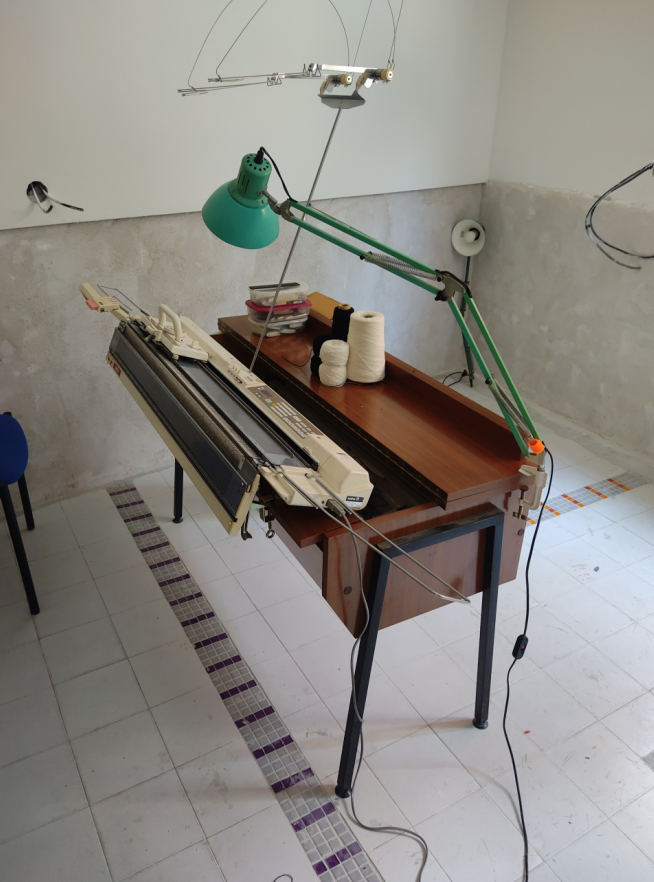
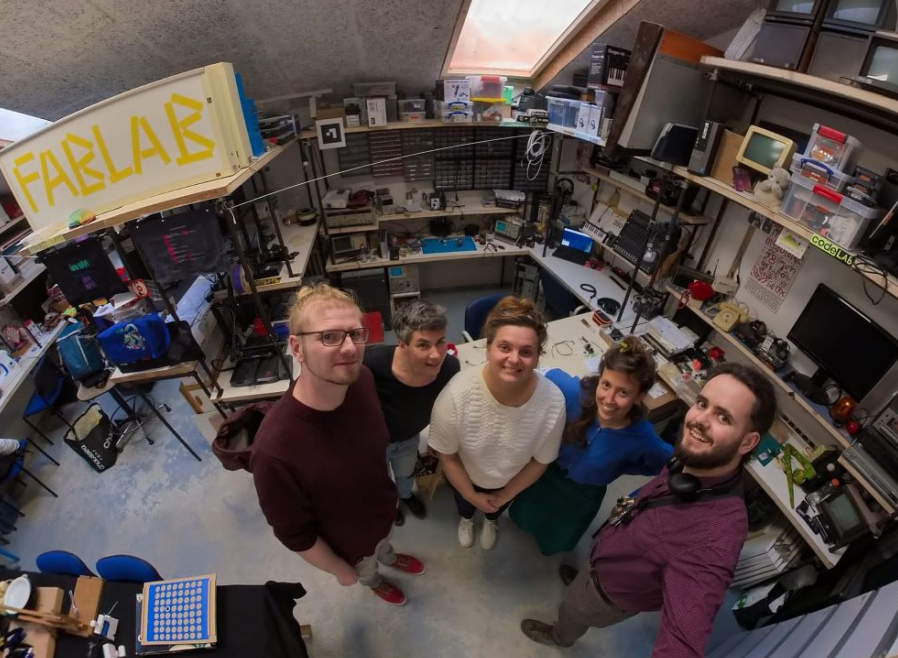
A 360° tour can be viewed here.
He who rests, rusts - Next town: Brest or Plougastel-Daoulas
The visit to Flux ended with Axel's workshop shoot and the onward journey towards Brest began ;-) Shortly before 8 p.m. and after some GPS coordinate chaos, we found the right road to Mathieu Rietman and arrived on time. We find accommodation on his property and have dinner with his family on the nearby beach.
Mathieu is an engineer and works in the ILDYS Fondation's Rehab Lab, where he has been making special components for people with disabilities for over thirty years. Mathieu is not only a working father and a gifted gardener and nature lover, he is also active in the UBO Open Factory (Université de Bretagne Occidentale). Mathieu is also self-employed on the side and sells specially developed modules for wheelchairs to motorize them efficiently and with a low threshold - he sells them under the name ForceWheel. These include everything you need: Battery, motor, mechanics, electronics and overall concept. We were even allowed to test it ourselves on the last day and had some fun with this very serious topic.
Excursus on the ForceWheel
A sample video from ForceWheel.
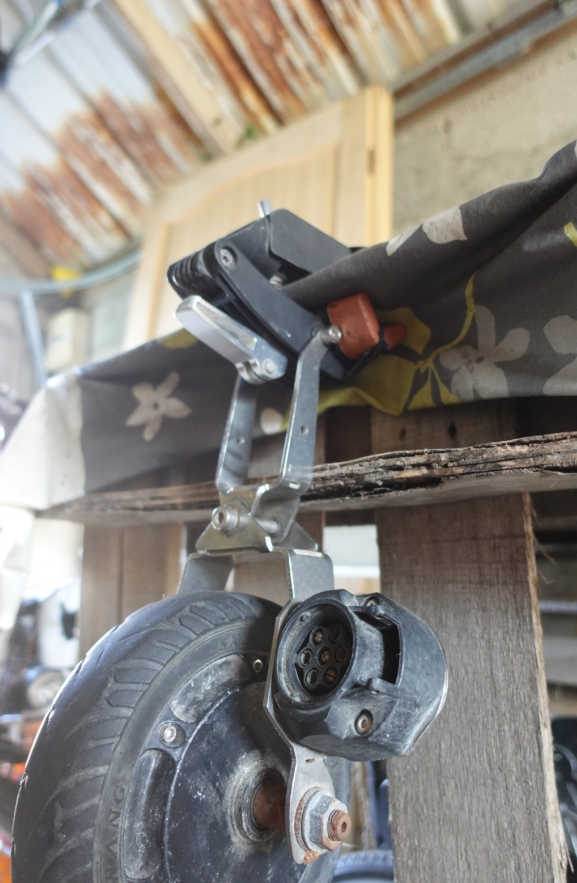
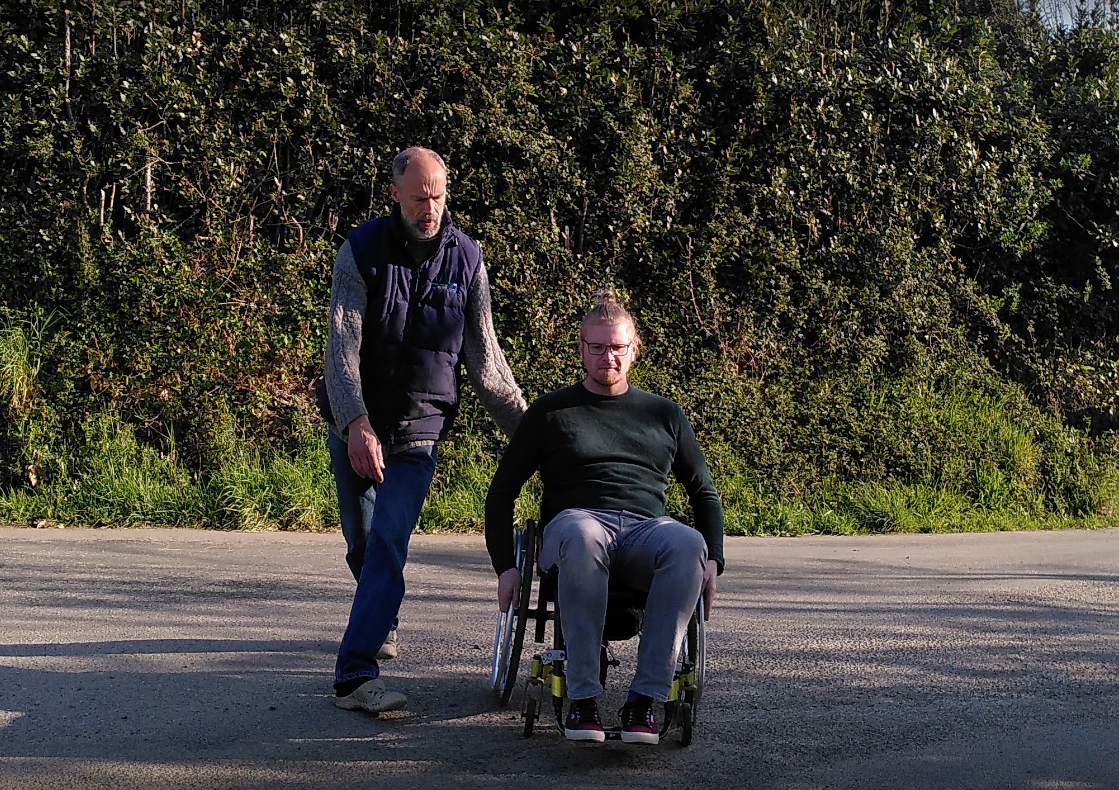
The first of two nights in the caravan gives us a break from the long day trip. We relax in the completely natural silence and darkness of the night, with the occasional crystal-clear call of an eagle owl and a starry sky - something special compared to the usual sea of lights and sounds in urban areas, where there is always something to orientate ourselves by.
Tuesday 08.04.2025
A breakfast together at Mathieu's rings the bell for new information content. Today's focus: the Rehab Lab in Brest, followed by the Open Factory at the UBO.
8. Lab visit - Rehab-Lab (ILDYS Fondation), Brest
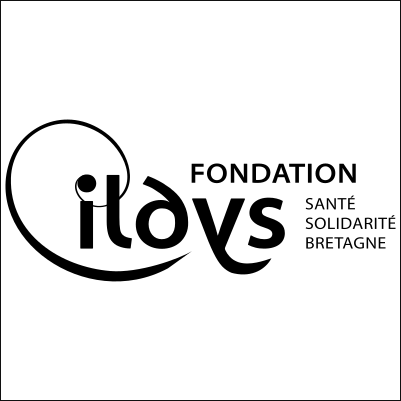
We follow Mathieu by car as he drives ahead to the workplace. The Rehab Lab is a laboratory attached to a public health center. Here, Mathieu develops an incredible number of different things such as prostheses, special drives, mechanisms, frames, brackets and more based on discussions, analyses, scans, casts, measurements and acceptances with patients. A tour of the rooms reveals the diversity and also the scientific and technical methods and concepts behind them. Mathieu is a passionate user of Fusion 360 and models extensively in 3D. For the realization of prototypes and individual pieces, he has access to various workshop areas, such as a small 3D printer farm and, for example, equipment for wood and metal processing or various laser cutters. Pragmatically, he likes to develop with inexpensive materials that are readily available and affordable. During our in-depth conversation, we first learn the difference between the terms orthosis and prosthesis: orthoses are additions that are used to relieve, support or correct areas of the body, while prostheses are used to replace missing or defective body parts.
Acceptance criteria and meaningfulness
According to Mathieu, there are many different factors that make a prosthesis or orthosis good and practical:
- does not hurt to use
- has a suitable weight and does not interfere with everyday life
- clearly fulfills its function
- is reproducible (standard parts, standard materials, simple manufacturing processes, etc.)
- is inexpensive
- is made of compatible materials (allergies and intolerances)
- also adapts to changes, i.e. is flexible (people grow, age, gain or lose weight)
- is as complex as possible: few different parts, few special parts
- can be developed quickly and iteratively
- and much more.
Mathieu is particularly enthusiastic about technologies such as 3D printing with PLA and TPU, laser cutting and working with PE/PP foams, as well as stable and lightweight plastic tubes and clamps, such as those from Manfrotto.
If one or some of these points are disregarded, the patient is usually dissatisfied in the short term and the product loses acceptance and its raison d'être (and may then only have generated effort and costs). For economic reasons, it is also problematic if customer solutions have to be devised in an extremely complex (time-consuming) manner, as the working time of designers is a dictating cost factor. This is particularly the case when difficult conditions, many parts and expensive special components or new firmware/software are required.
These and other facts alone represent years of practical experience that cannot be bought and can only be significantly improved by working together with many people and patients. Of course, this also includes working with standardized works that exist so that design concepts or finished components - i.e. the wheel - do not have to be reinvented. Notable examples are eastin.eu and rehadat.de.
Keyword autonomy
An important note that we chisel from Mathieu: Autonomy for disabled people should be established as early as possible by actively getting them moving and quickly providing them with suitable aids with which they can learn to deal with their special situation from the crawling phase and internalize this.
Responsible use
As we are involved in 3D printing and IoT issues ourselves, we are pleased to learn that, in addition to products such as 3D printers and home automation modules that are far too often used for gadgets, there are also really useful scenarios that at least some people will certainly think of - especially if they make it possible for people with disabilities to make things inexpensively or create a degree of independence - for example, by automatically opening a door at home using a hinged mechanism when the appropriate command is given by voice control or a simple flick of a switch in a wheelchair.
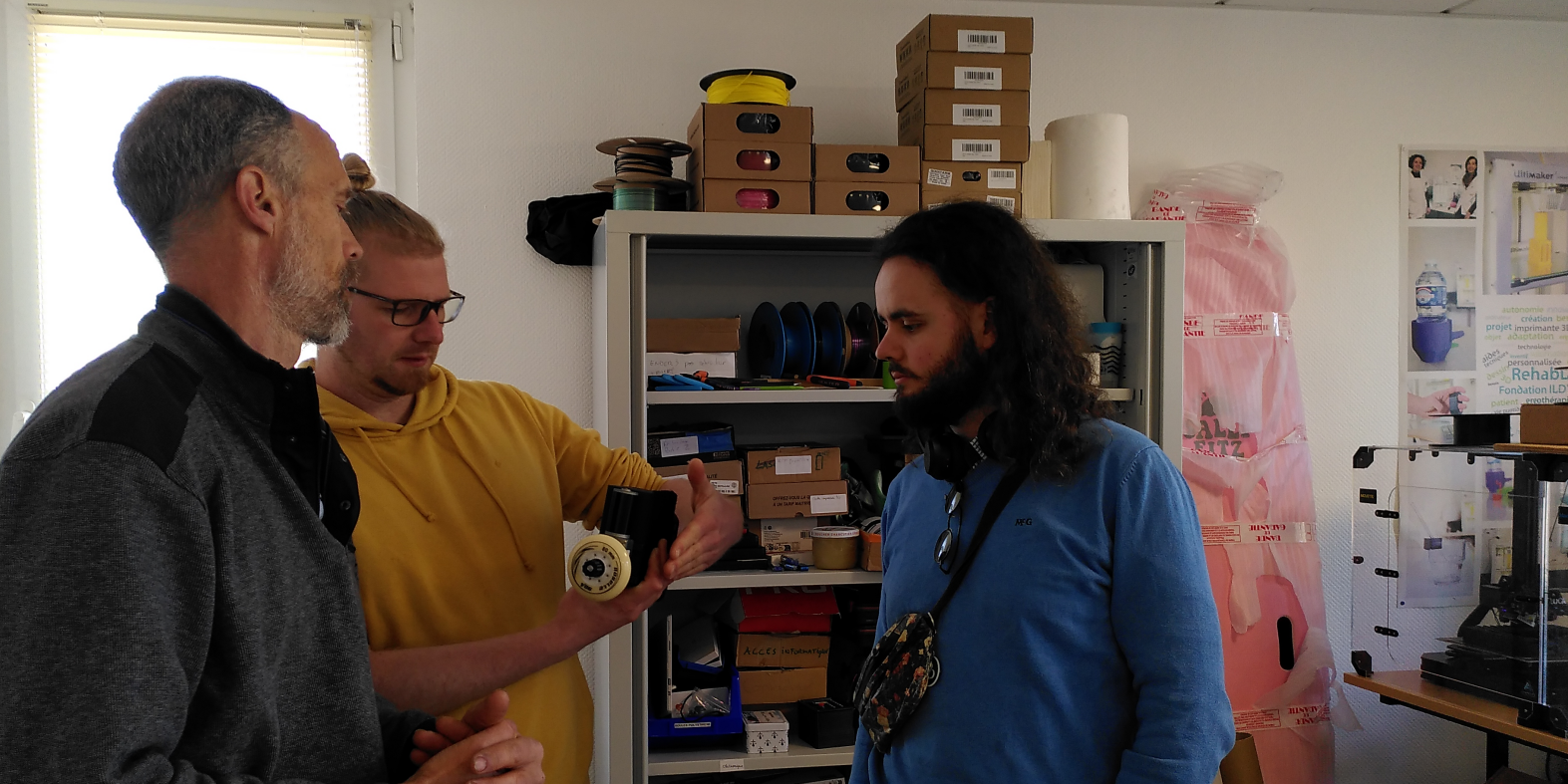
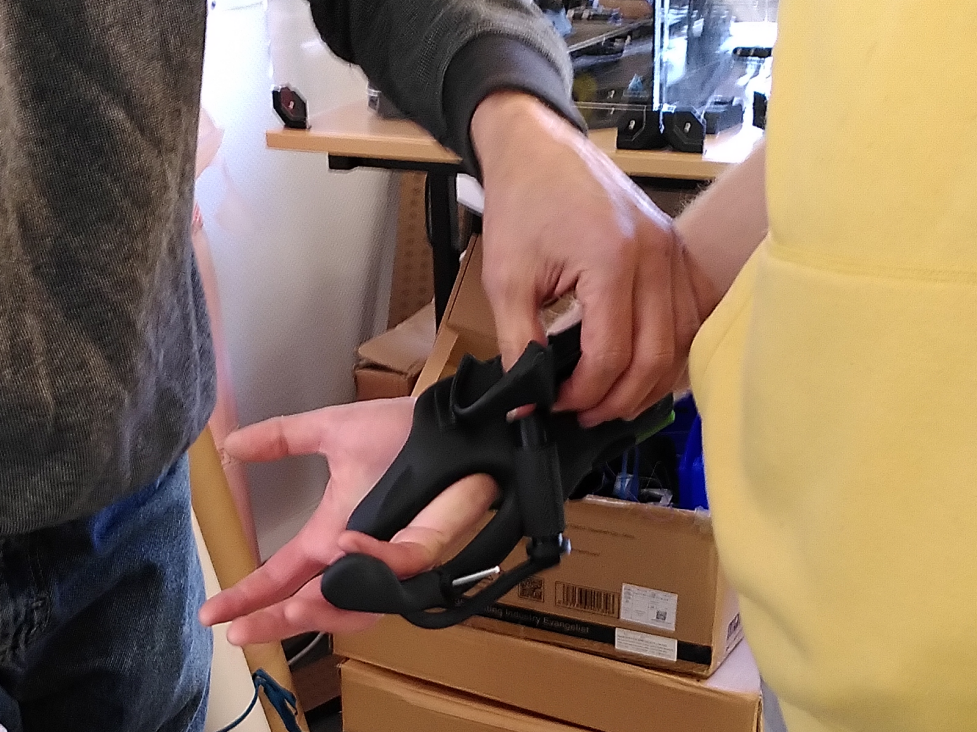
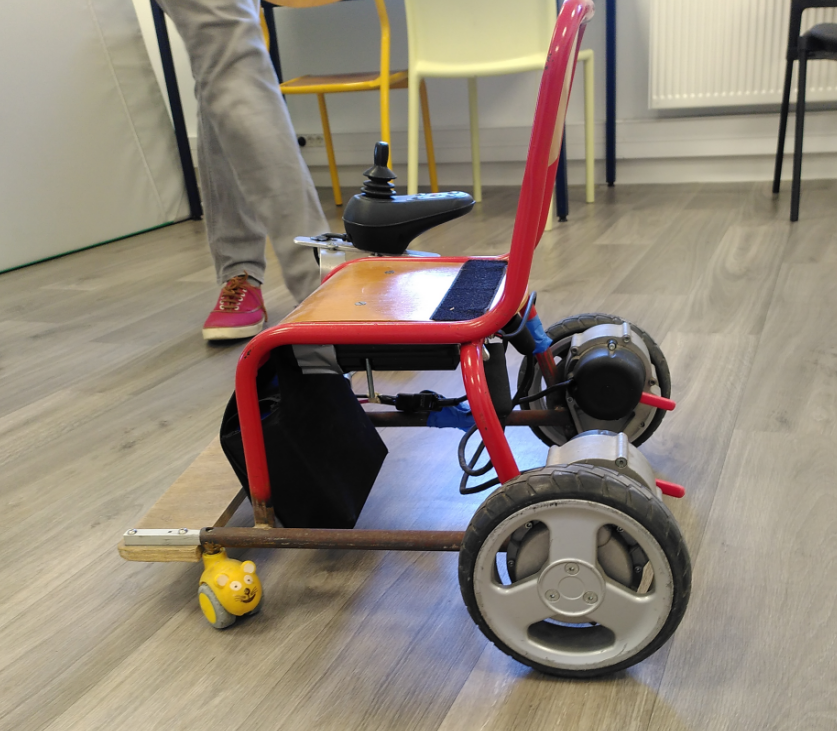
Wheelchair for a small child
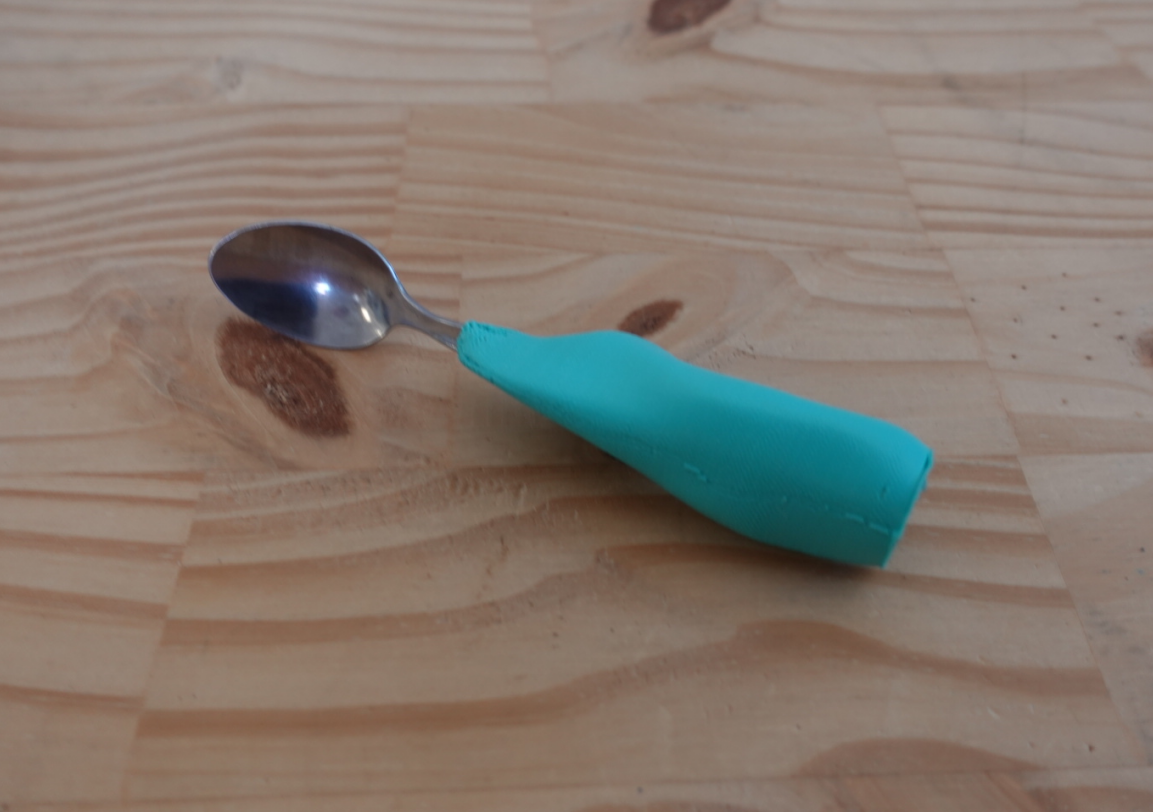
Mobility for mobility
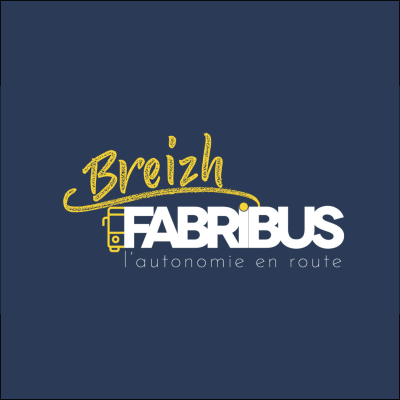
The ILDYS Foundation is not tied to just one location. In addition to various locations in different cities, it also has its own van called “Breizh Fabribus” in cooperation with the UBO. With this mobile workshop with the slogan “Autonomy on the road”, Mathieu and his colleagues regularly go on trips to various areas in the Betragne that are less accessible for disabled people and offer advice, quick fixes and workshops, among other things. We were allowed to take a look for ourselves and go along for the ride.
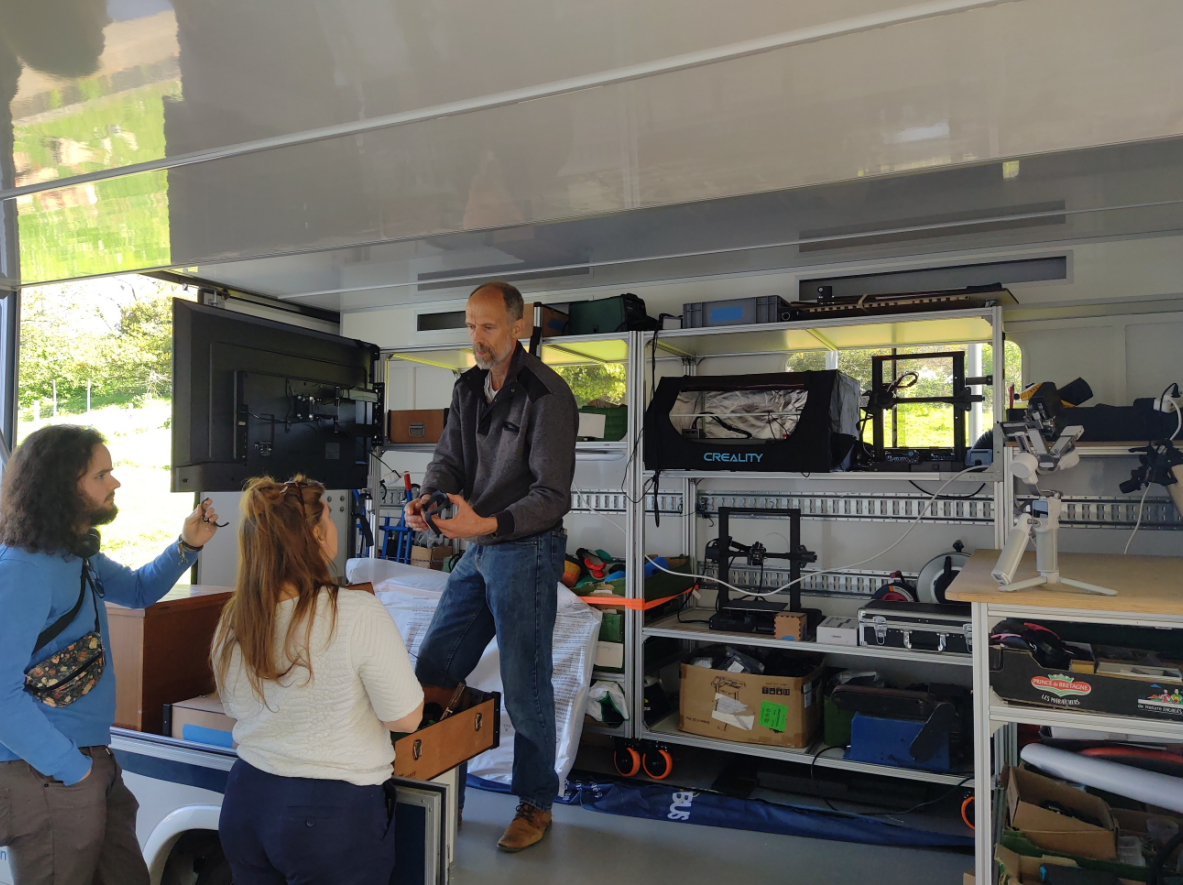
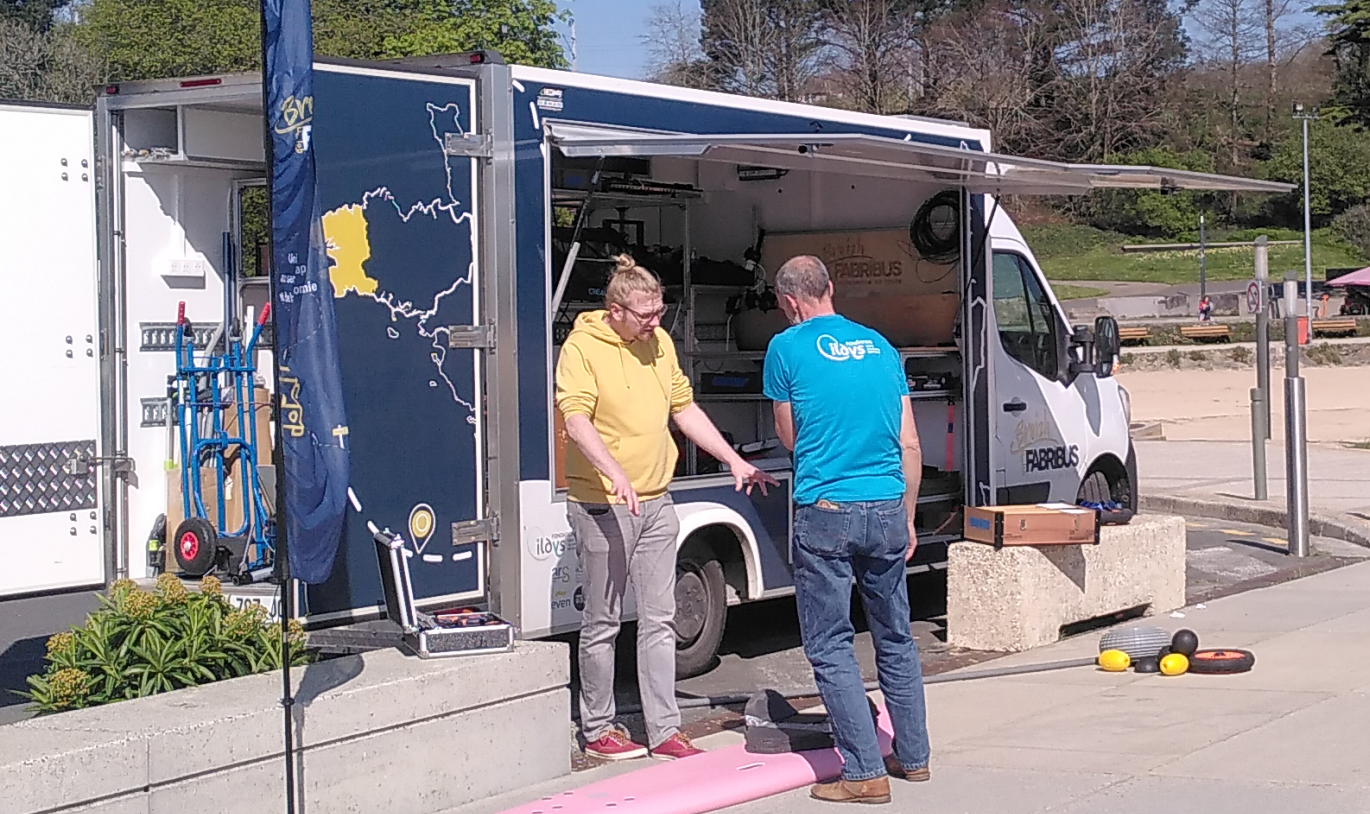
9. Lab visit - UBO Open Factory, Brest
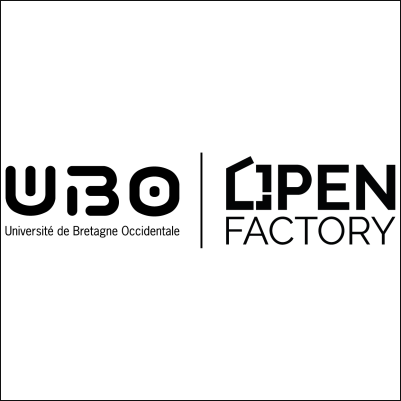
In the afternoon, we pay a visit to the University of West Brittany. Our destination is the Open Factory.
As soon as we arrive (and again late), we are already directly integrated into the 1.5-hour Inkscape beginners' course in French, together with a handful of other participants. Adamou Amadou Soley therefore greets us rather briefly and immediately hands us laptops - with a French keyboard layout :-D.
We end up spending the whole afternoon until early evening here. After the course is over, there is time for in-depth discussions.
Axel, back in his virtual reality element, starts taking photos. Babette and Mario talk to Adamou, who shows various products that have appeared at the UBO, among other things against the background of the joint cooperation with ILDYS. These include a wide variety of things, such as visually beautiful and tactile card games that can also be used by blind people. There are also prosthetic hands and modified canes for the blind.
Adamou himself is dependent on walking aids, but is not discouraged. On the contrary: he is fully integrated and is the Fab Manager of the Open Factory.
Inclusivity at the university
It's not just the UBO that has something to do with this topic. In general, we hear from Anne-Emmanuelle Le Minous that the university recently received funding approval for a three-year project to make the building fundamentally more inclusive. The main aim is to ensure that people with various disabilities, i.e. the real users or those affected, can help shape the building themselves from the outset in order to identify and tackle the existing weak points in the building complex. Because the problem, as Anne explains, is often that parts of buildings, paths and signage, acoustic announcements, Braille markings, etc. for disabled people are built according to standards, but without integrating those involved in the ongoing process, who can, however, provide valuable feedback for the localized solutions and would also see/feel the resulting solutions more as their own. So this is not just about building substance, but about inclusion. As an association, we now know very well how important it is to establish and maintain trusting communication as early as possible in the planning and implementation of construction measures. Otherwise there will be a lack of acceptance later on, time and money will be lost and many things will have to be redone. Similar to what Mathieu describes, meaningfulness and goal fulfillment is a sensitive process.
Animal Fab Members
During our stay, we experience another curiosity. Alain Theillier, who is also involved in the Open Factory, is the keeper of a very special bird. He always has a visually impaired seagull with him, a tame companion that always makes the workshop a happy place - because hardly anyone can ignore the cozy feathered friend Arec le goéland. One day, Alain received a visit from the seagull at his own kitchen window, which eventually came more and more often until it stayed. It has become a close and special friendship, which is currently being made into a movie.
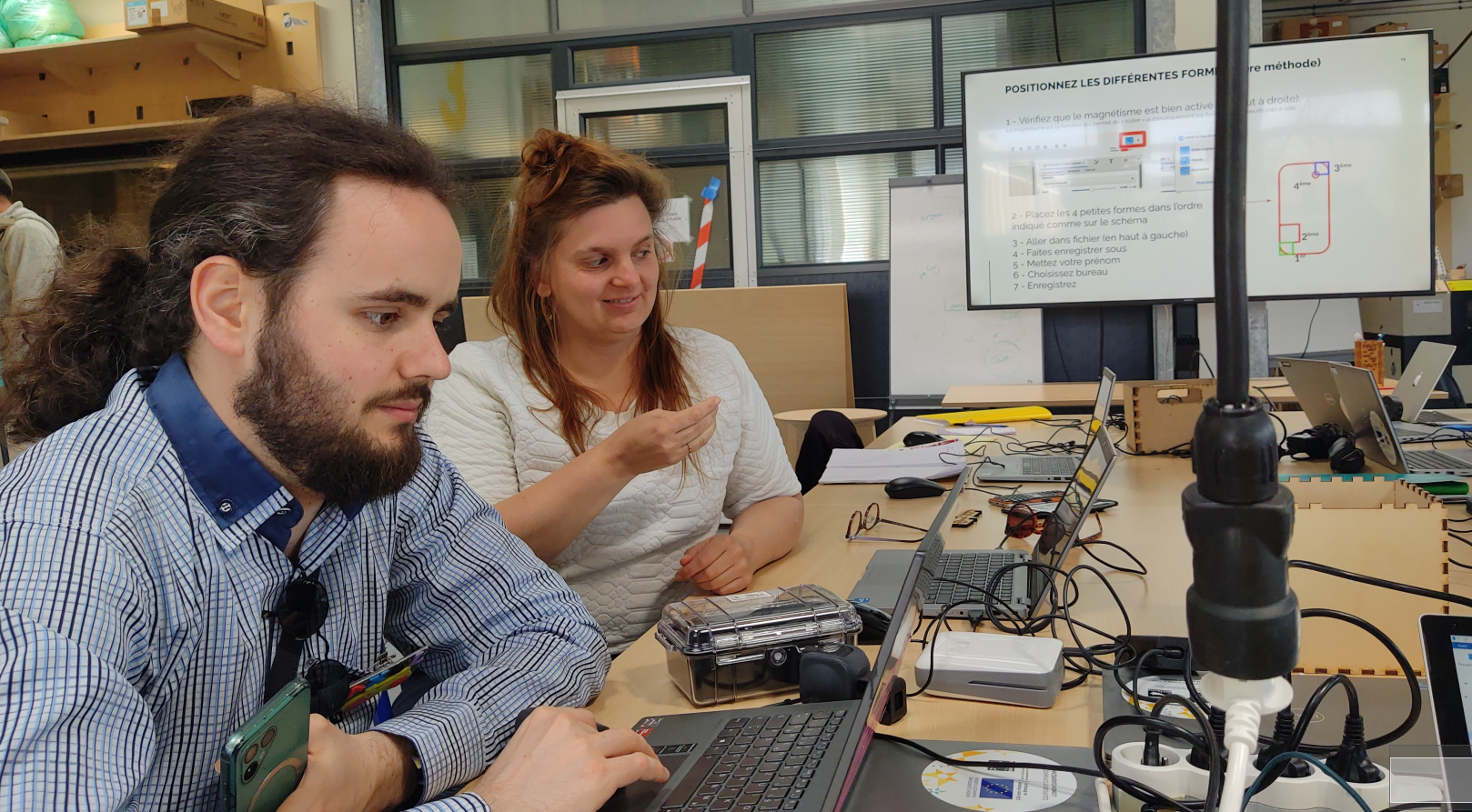
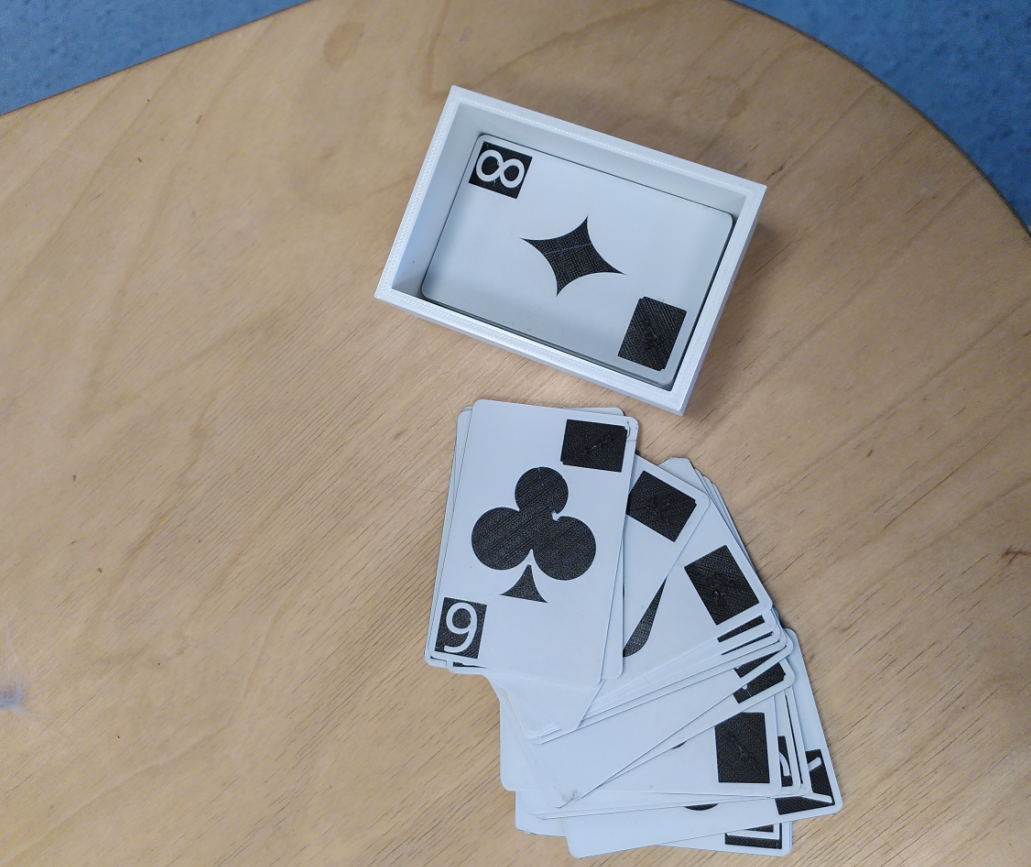
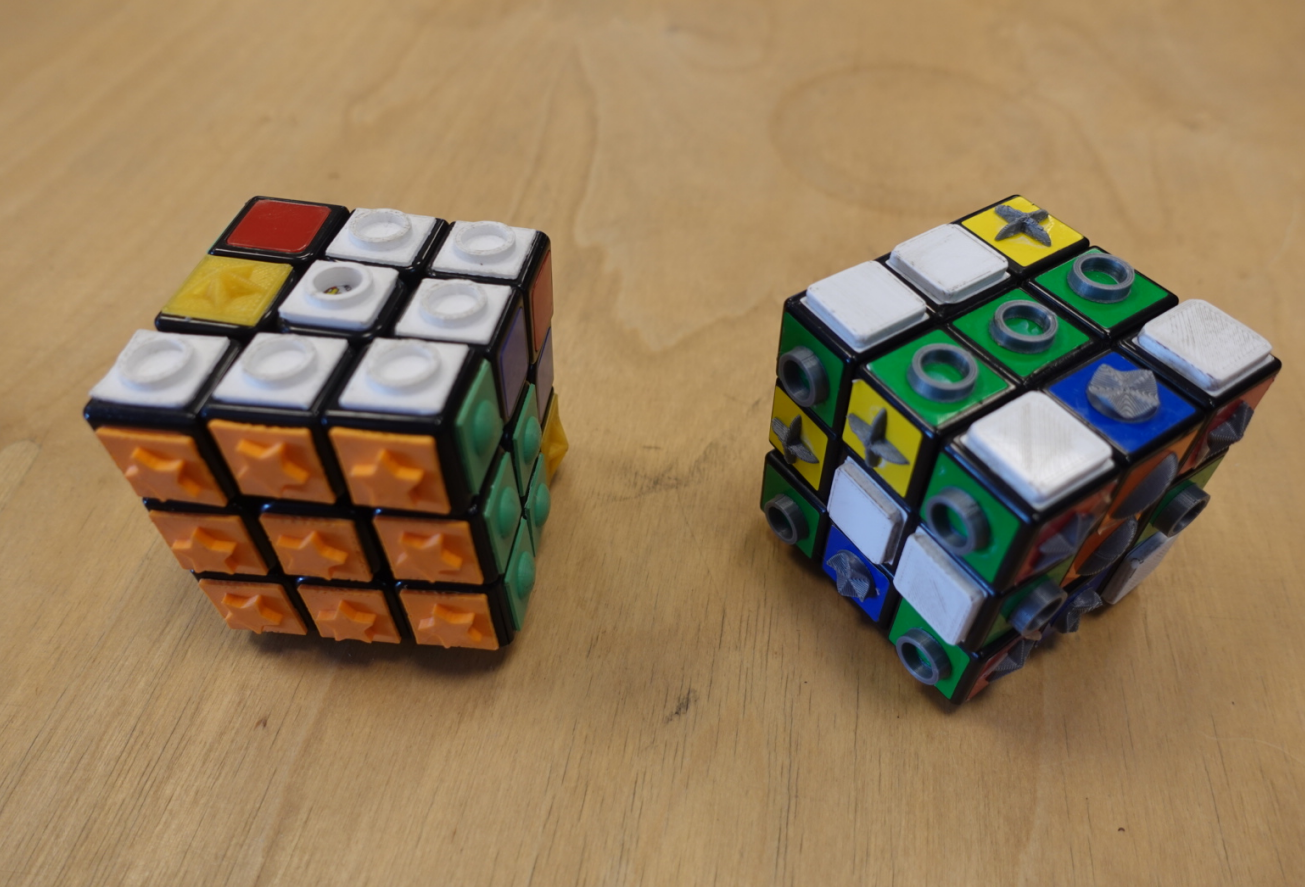
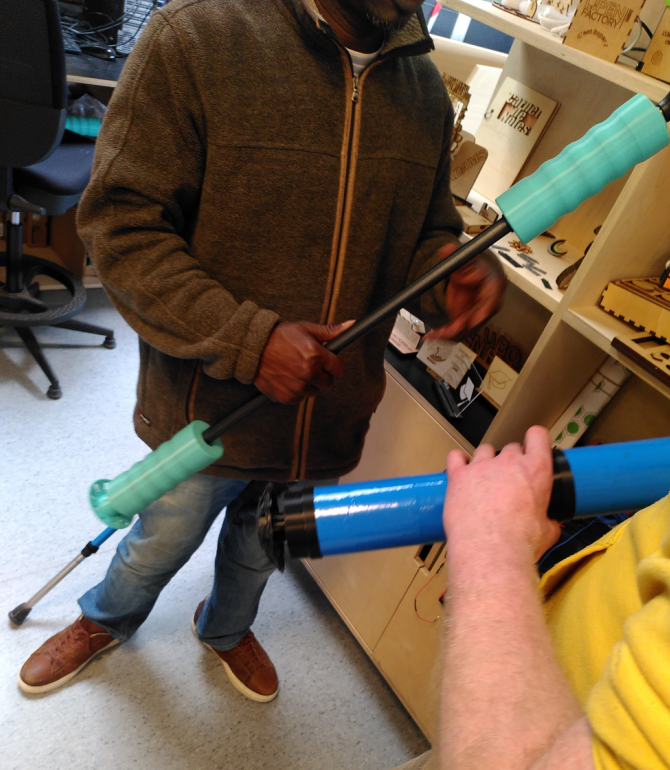
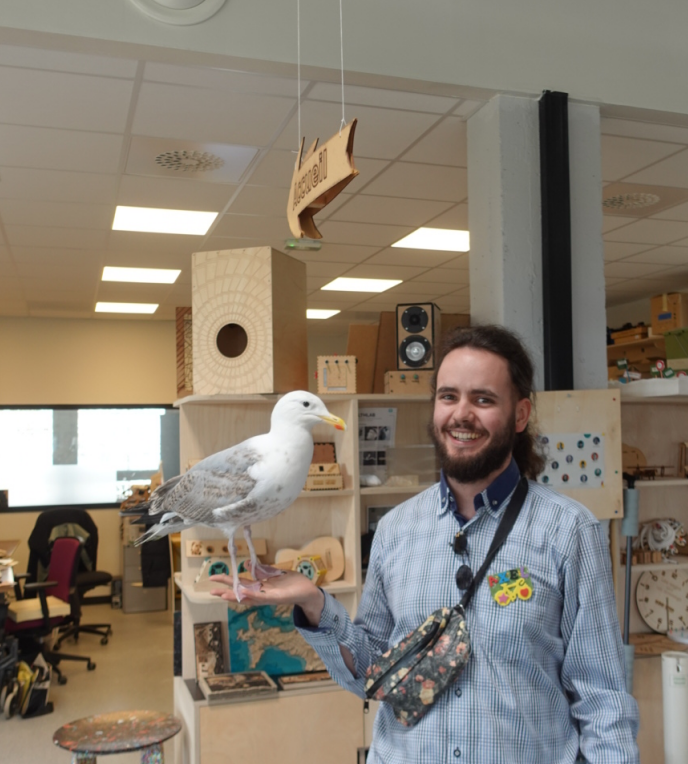
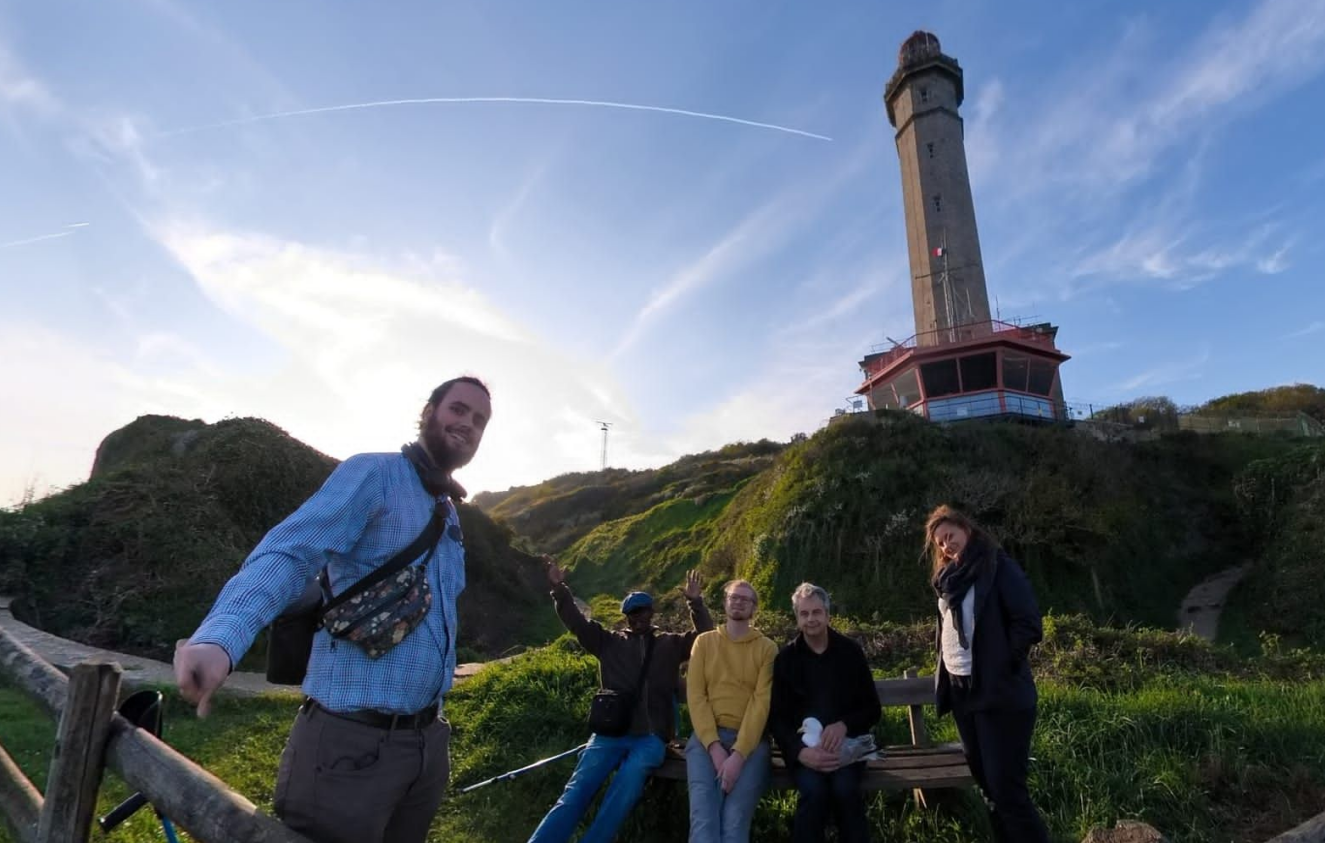
Wednesday 09.04.2025
Wednesday began with saying goodbye to Mathieu in the morning. After we had packed up our gear and stowed it in the car, we set off for Morlaix. We unloaded Axel at the train station so that he could accompany Maik further south. They meet up together in Paris and drive on to the Makers de Montagnes in Manzat.
The day stretched out with quite a lot of time behind the wheel and on the train: we returned the rental car in Rennes and took the train to Paris Montparnasse. We finally reached our accommodation at around 8 pm.
Thursday 10.04.2025
10. Lab visit - E-FABRIK, Drancy
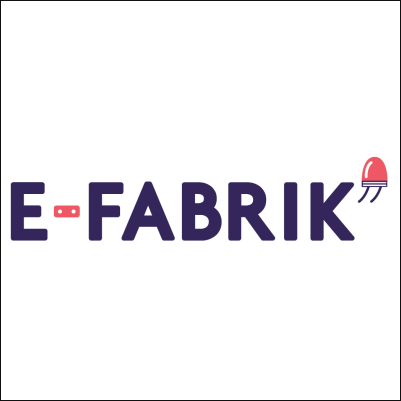
Found after a bit of searching and phone calls: The E-FABRIK. Maik had already been a guest here just two days earlier, as his southern tour also took a detour via Paris.
We first meet Pierre Berrier, who shows us around and explains what the E-FABRIK does and what it stands for. Pierre recaps that the E-FABRIK is a meeting place that initially started out as a mobile project in various FabLabs in 2015. The founders, the TRACES organization, essentially had one core idea, which they tried to bring together in something like this: Take a well-equipped makerspace that is accessible to local residents and work with a group of young people there to develop something for people with disabilities. These young people - often from the School of Second Chance program - get to know each other and the FabLab encourages them to try out how technical and social issues can be solved through their own initiative. They will learn how to use typical digital and manual tools such as 3D printers, laser cutters and soldering irons. You will also learn how to use software such as CAD and design, circuit diagrams and coding in IDEs. They also train in general organization, such as writing formal letters with emails, planning calendars and helping to design workshops and interacting socially with different age groups. What they also learn to understand are the different everyday routines of disabled citizens, some of whom are also accommodated in residential groups, and the challenges they face in life as less autonomous people.
Thanks to the continuous feedback from the E-FABRIK instructors, the input of the disabled people and the creativity of the group, they develop prototypes within around six months that are designed to provide practical help. And because this works, the E-FABRIK was opened as a permanent location in Drancy in 2018. This mentoring and learning program has been running regularly ever since. There are currently around 4-5 groups, each with 2-3 young people.
Maxim and Arnaud, who are also part of the E-FABRIK team, show us around and get us talking to the graduates, who are noticeably more relaxed when we talk to them. It doesn't take long before we discover the use of open source tools such as Inkscape and immediately initiate a contribution in the form of a Mightyscape installation on a Windows system.
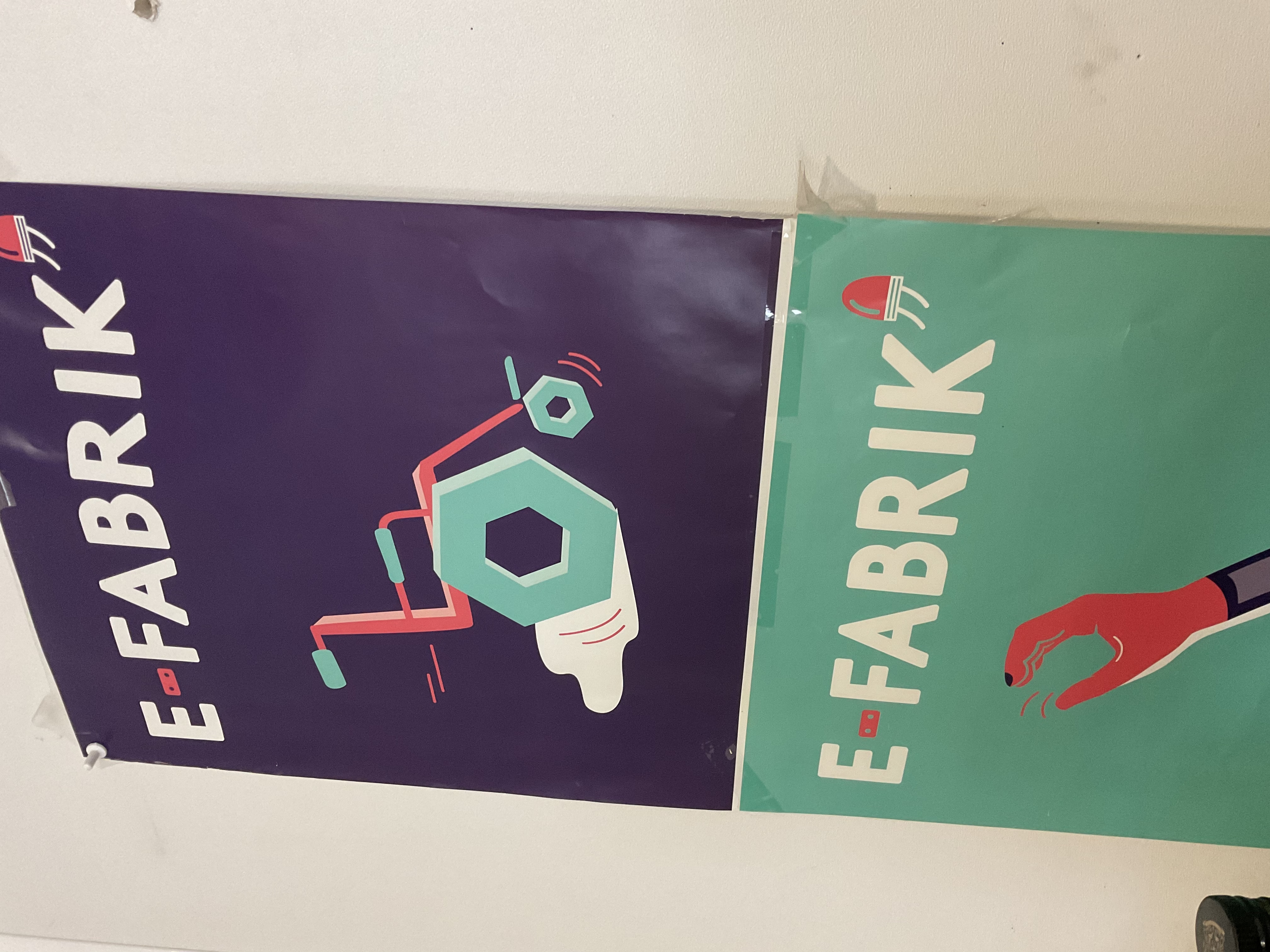
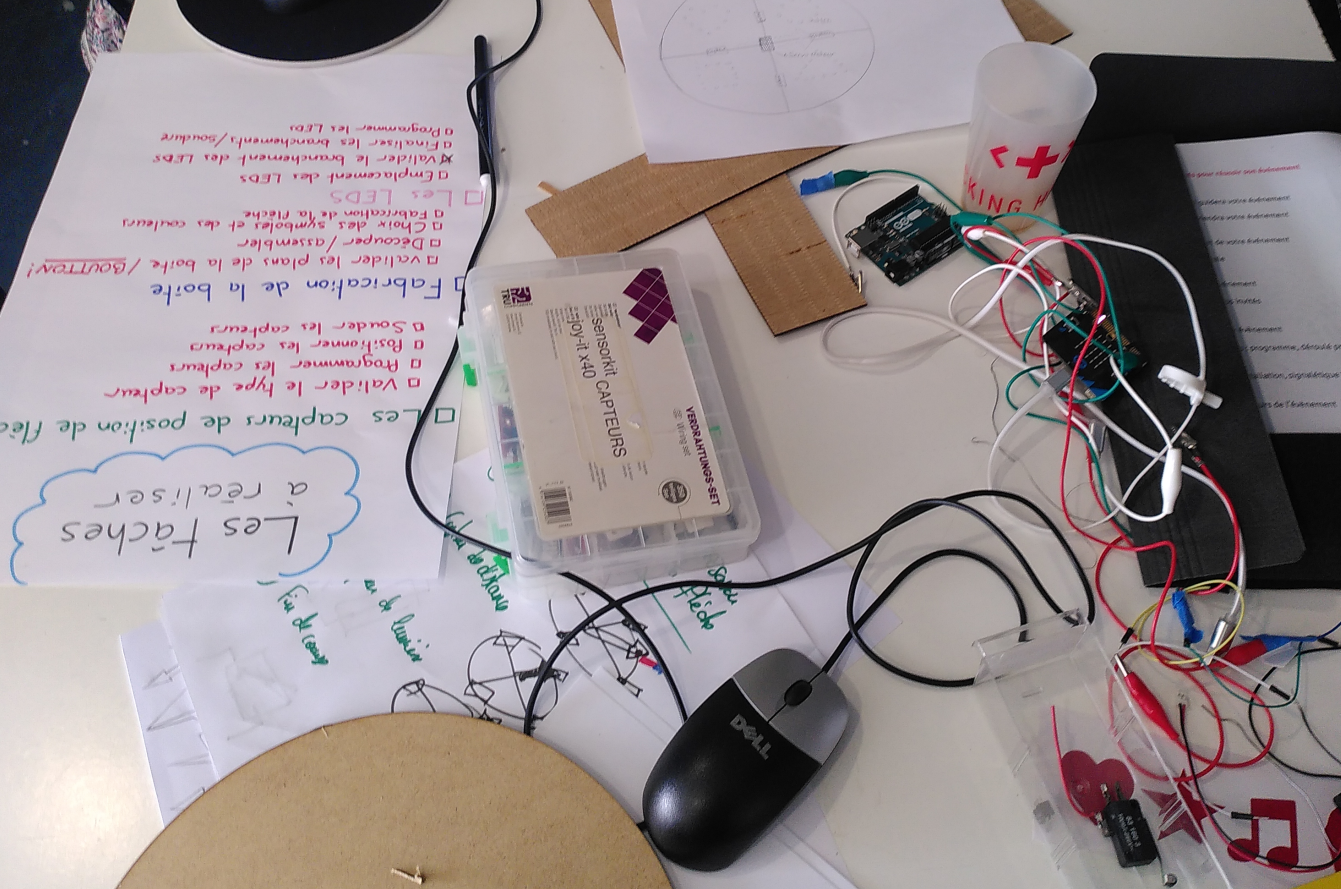
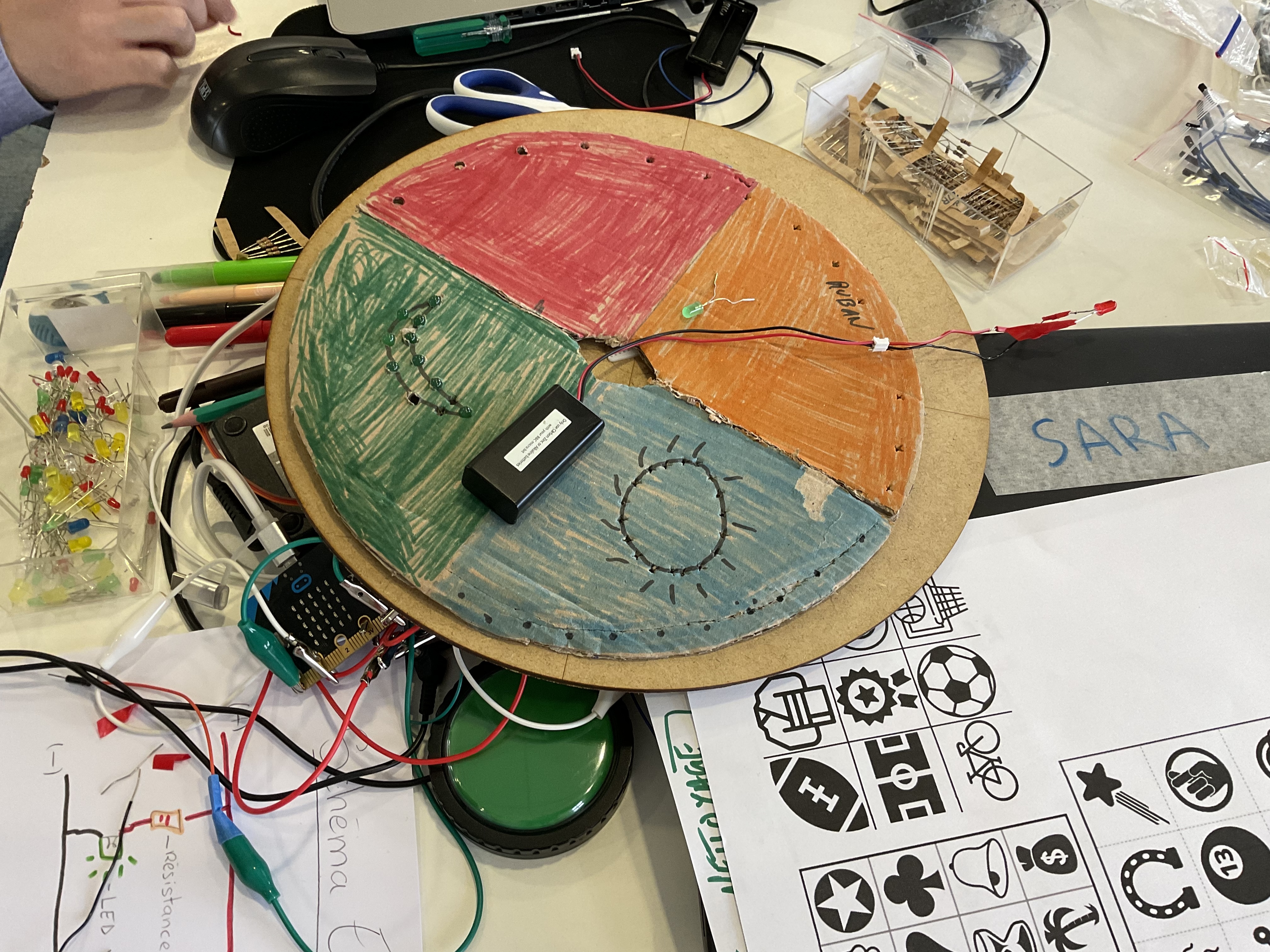
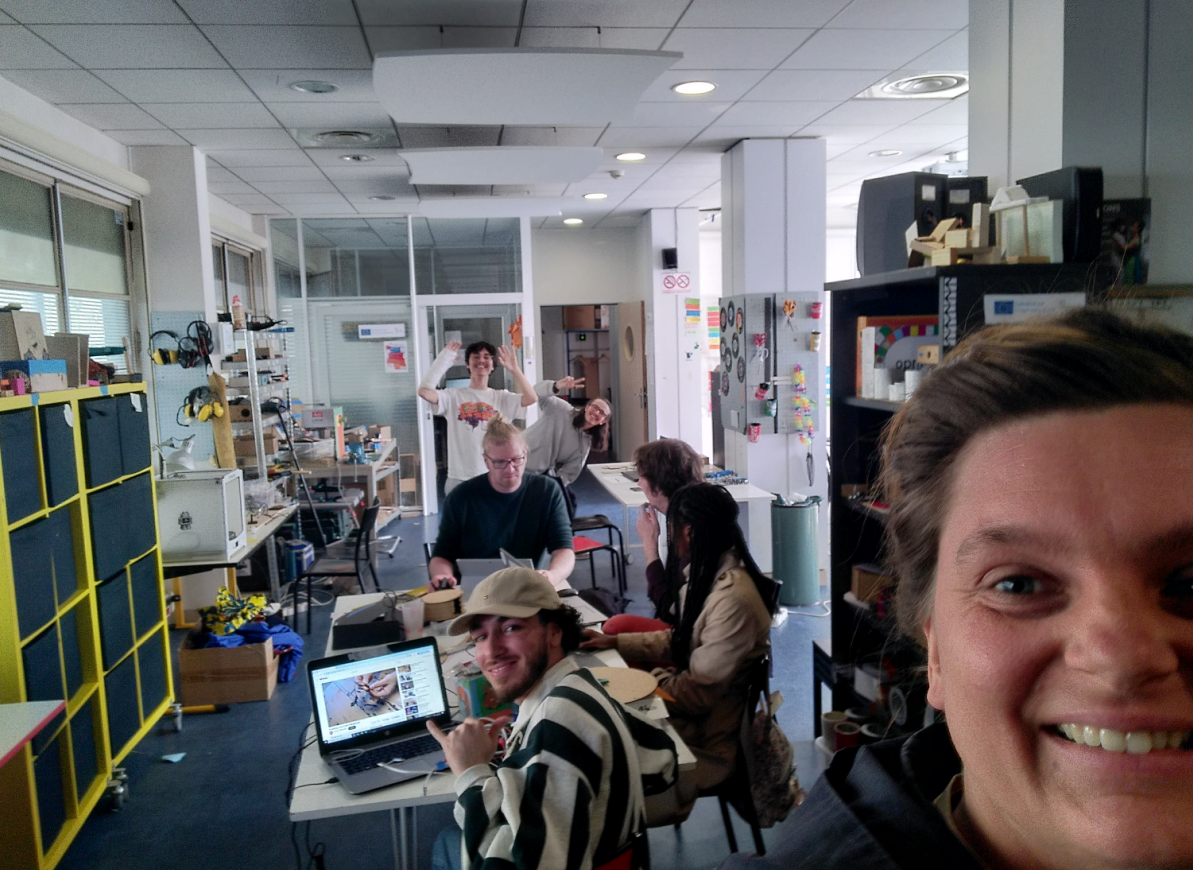
Friday 11.04.2025
Today is free time! We explore Paris on foot and by metro. Also on the agenda: Cité des Sciences et de l’Industrie.
Saturday 12.04.2025
The return journey by train from Paris to Chemnitz is imminent. With a punctual connection to Mannheim, we still believe that we will arrive home on the same day. With a delay of over 2 hours and the train to Leipzig being diverted via Kassel due to an accident on the road and previous delays due to damage to the train, we end up taking a cab from Leipzig to Chemnitz. Completely exhausted, we fall back into bed and process our journey.
Side notes
Of course, we also talked a lot about Chemnitz during the tour. To underline this vividly, we also had a few nice gifts for everyone. In addition to stickers, Tino's popular miniature Karl Marx promoted his additively and the city map Stadtkarte ChemnNetz, recently initiated by Bordsteinlobby e.V., underlines our beautiful places, which will hopefully soon be visited by some new French friends. We would be delighted.
Apart from Axel, none of us speak French. That worried us a little at first. However, these were unfounded, as we soon found out, or rather repeatedly. The younger generations in France speak fluent and very good English, a few even speak some German. We managed to communicate very well with others and were very pleasantly surprised.
Support / funding
The project is being supported by the Franco-German Citizens' Fund (Fonds Citoyen Franco-Allemand) from April to July 2025. Our supporters and companions are the French partner network RFF Labs, the German umbrella organization Verbund Offener Werkstätten e.V. and the European Vulca organization for international relations between open workshops (aka makerspaces), of which we are also a member.
We are grateful for the financial support and the great network exchange, which was already possible a few months before the trip thanks to the commitment of many people, especially RFF Labs and VULCA.

Last but not least, a clip about the Fonds Citoyen Franco-Allemand:
Thanks also to Axel from the Zentrum für Austausch und Machen (ZAM) and the Industrieverein Sachsen 1828 e.V. for providing tips for the Sachsenlotto “Möglichmacher” campaign. Part of the funds will go towards this project.
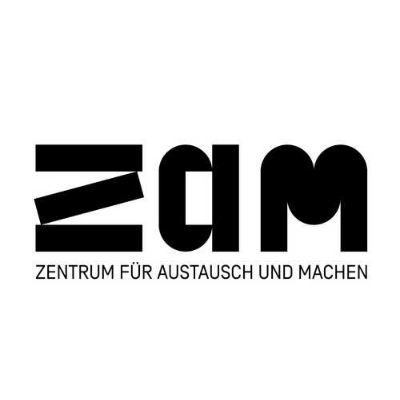
Back in Chemnitz
Yesterday we had our first evaluation session with Maik. He also brought us Hugues CCLab cap ;-) At the next opportunity you'll find out more about part two of Maik's trip, which visited almost twice as many places as we did.
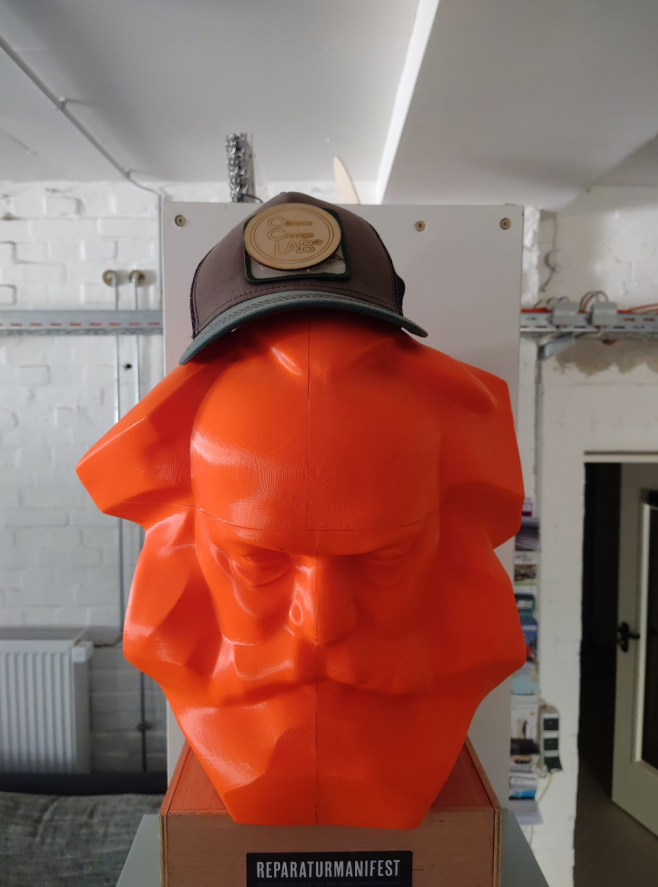
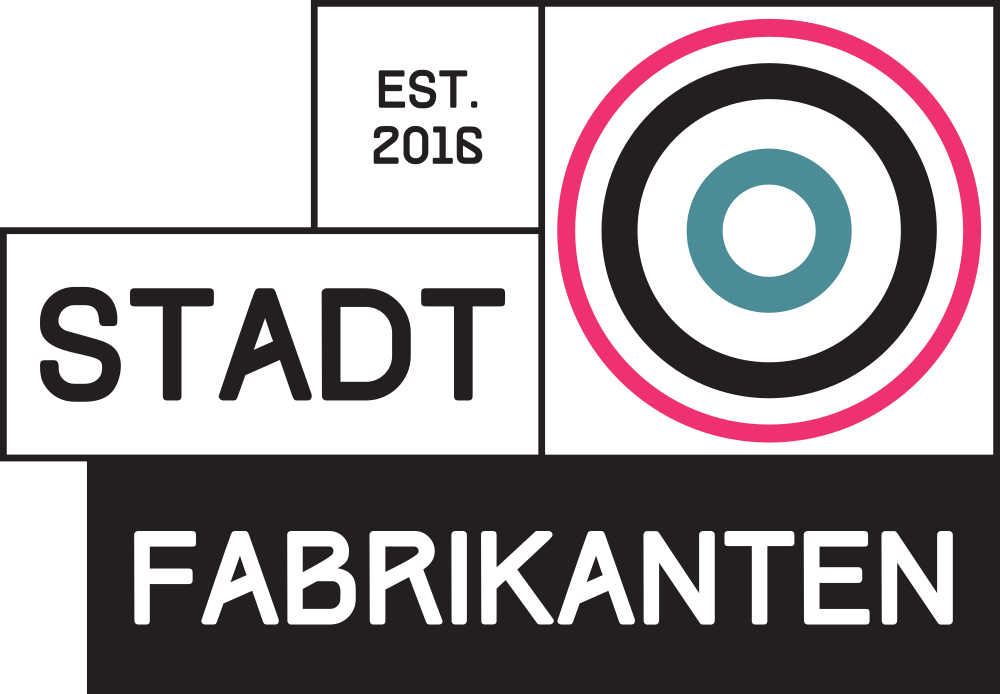

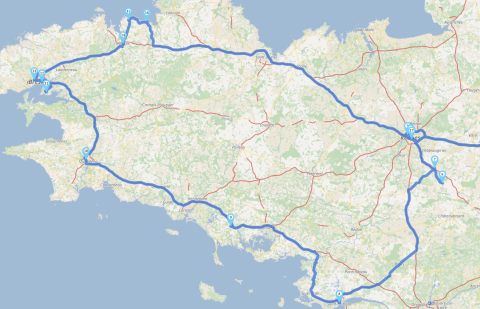
Comments